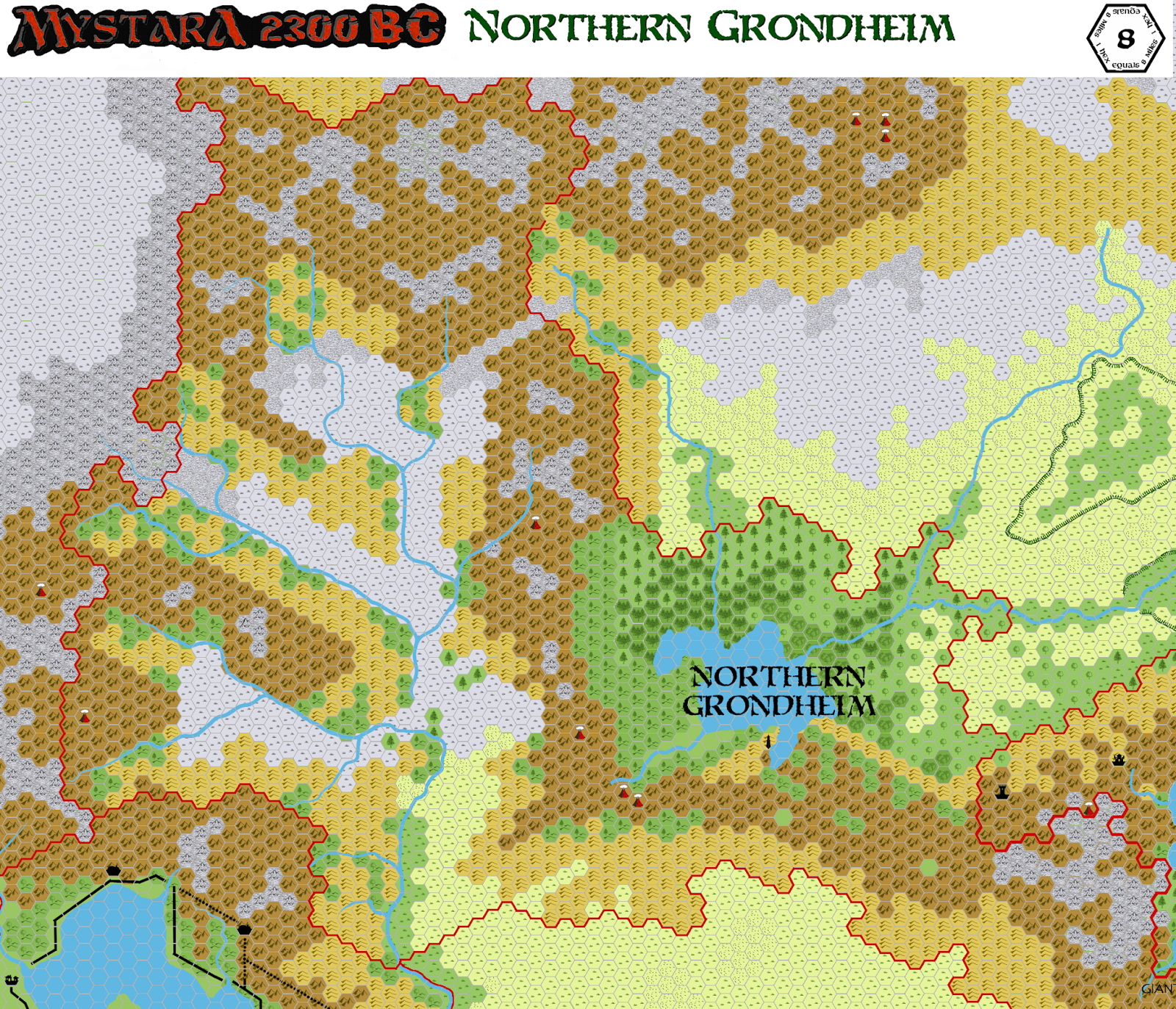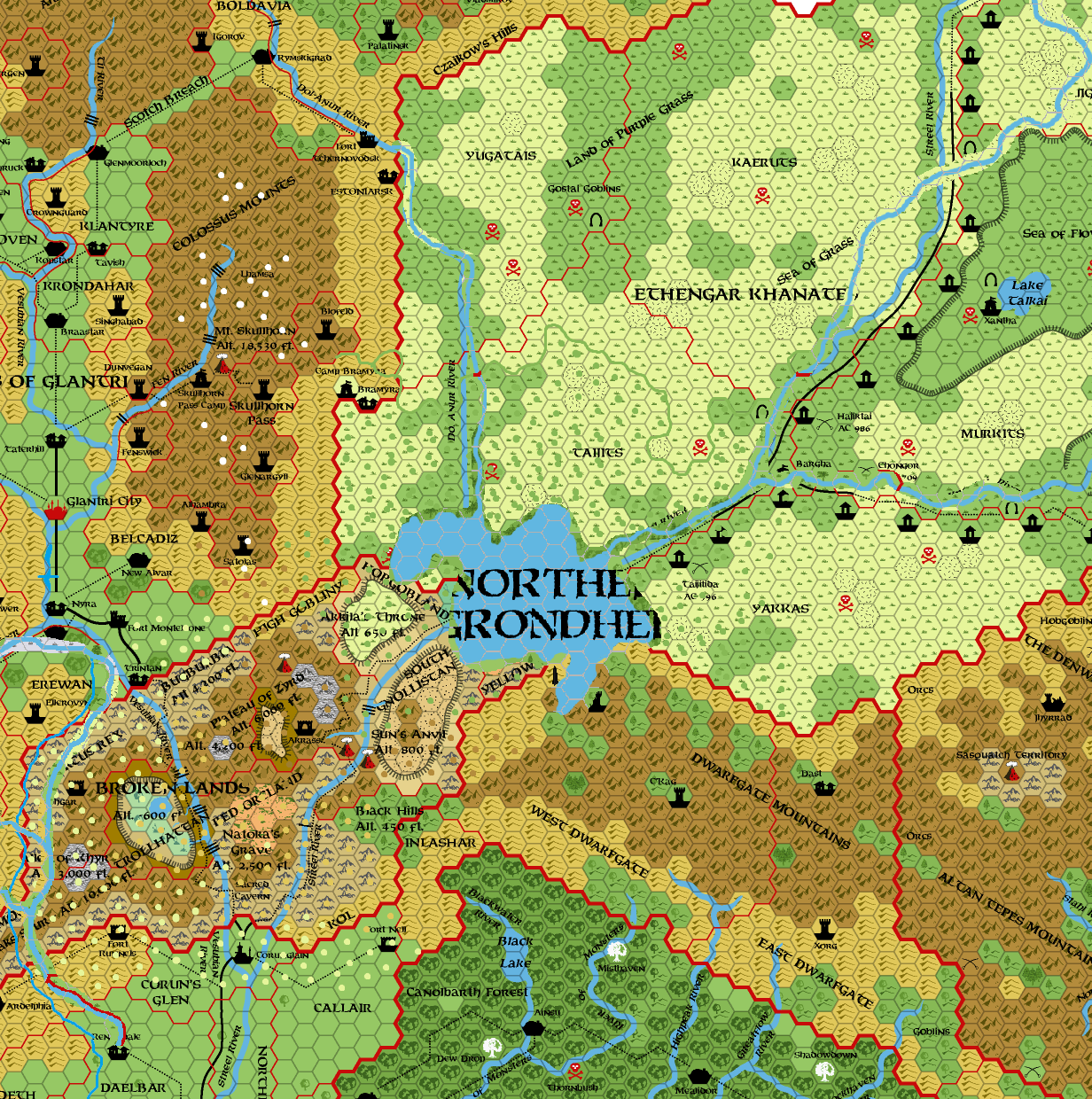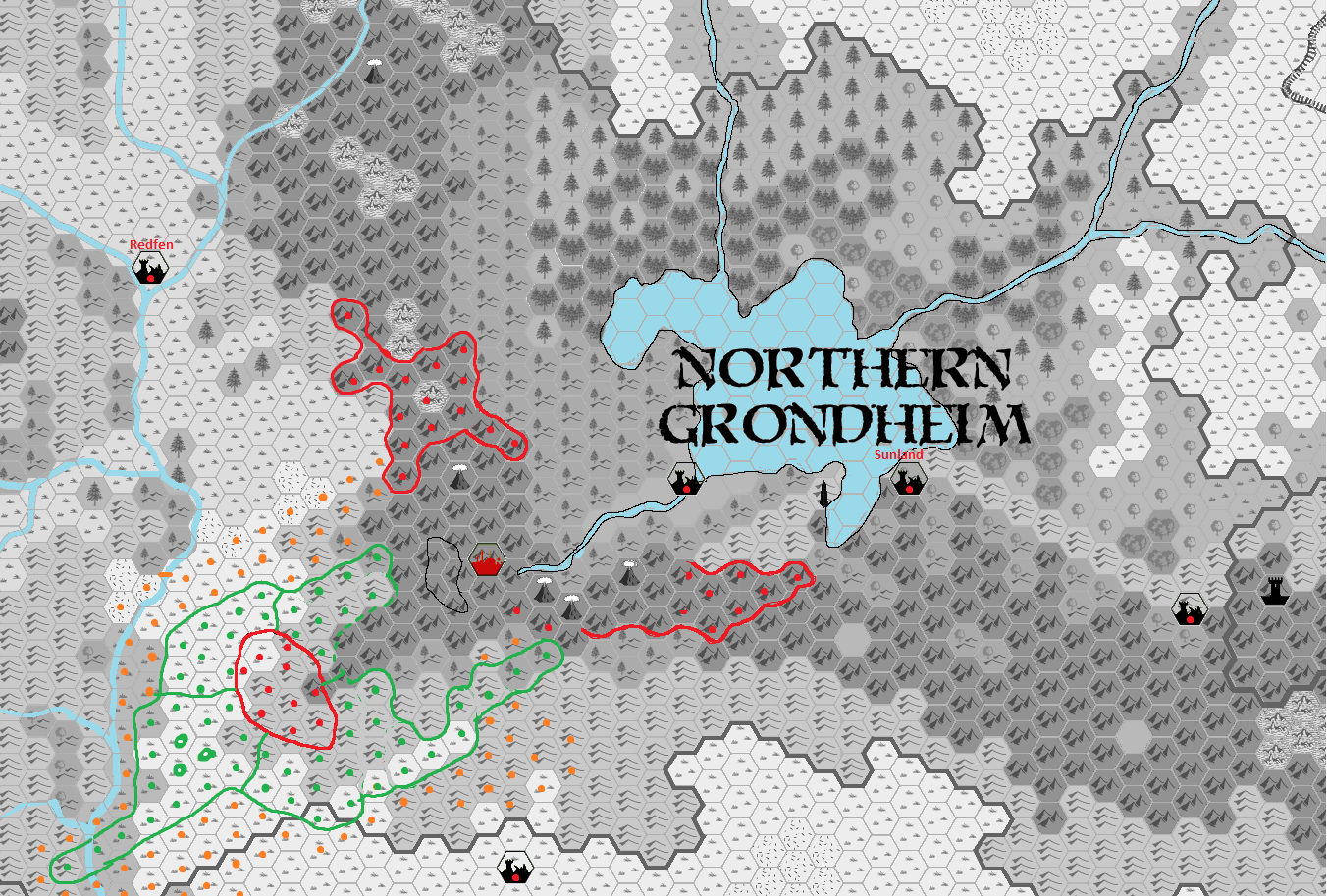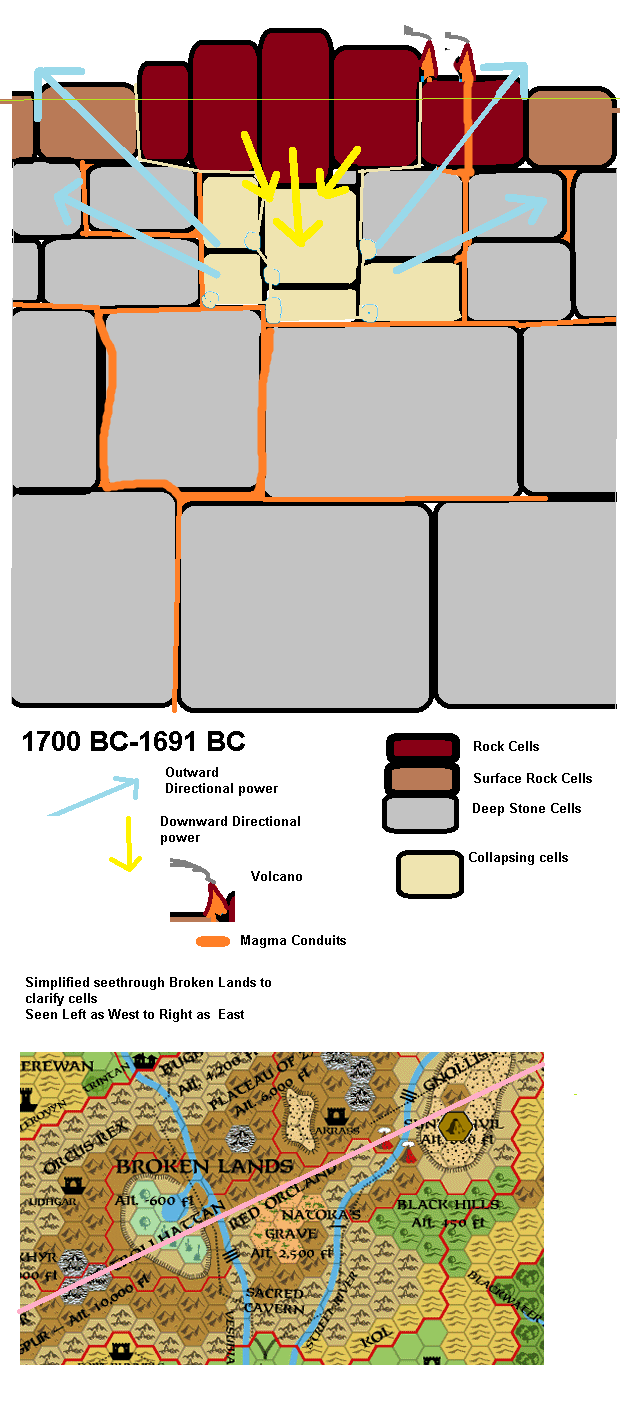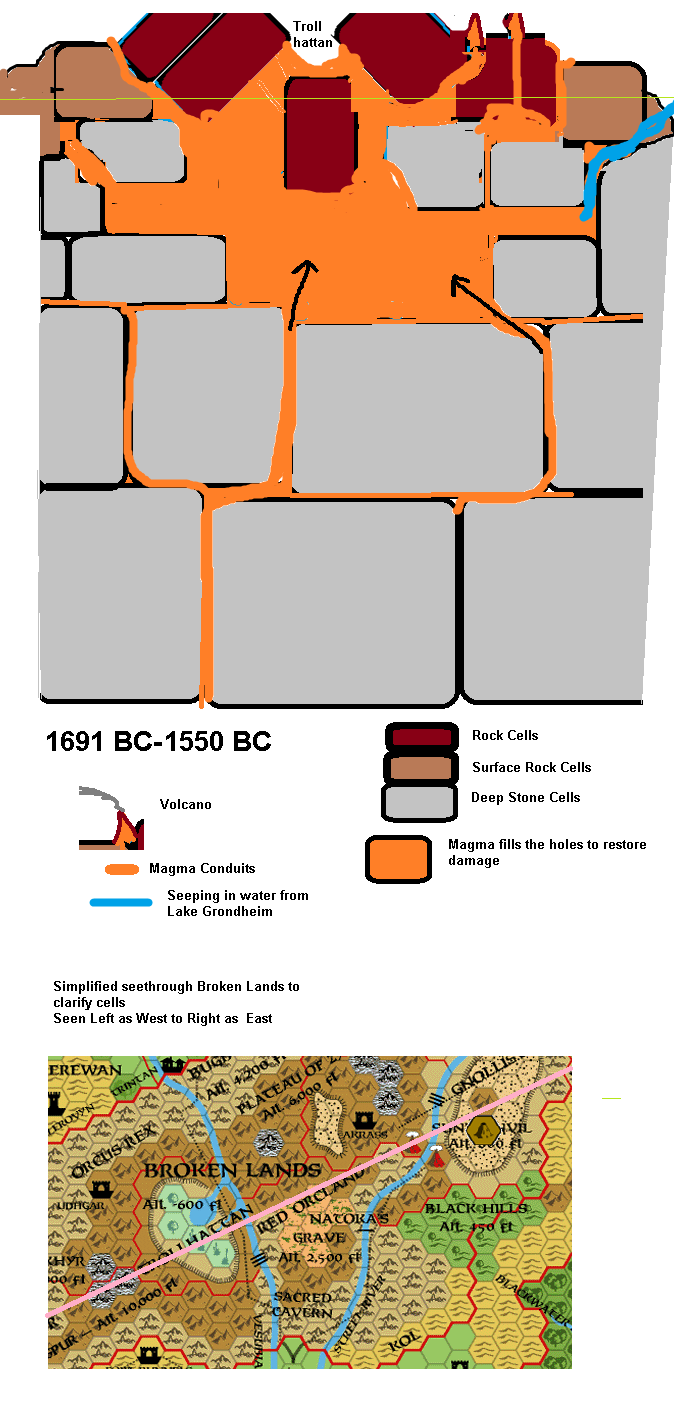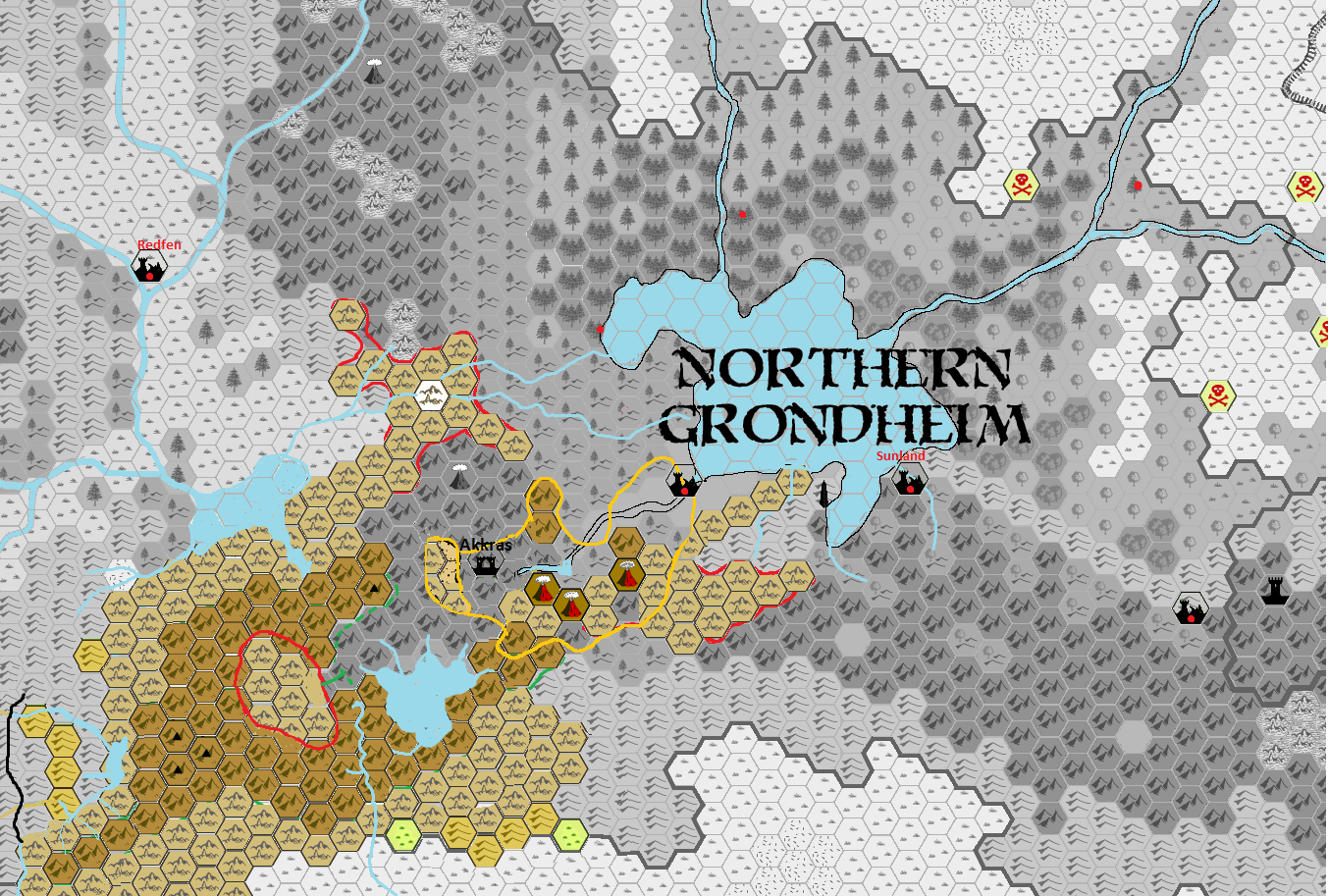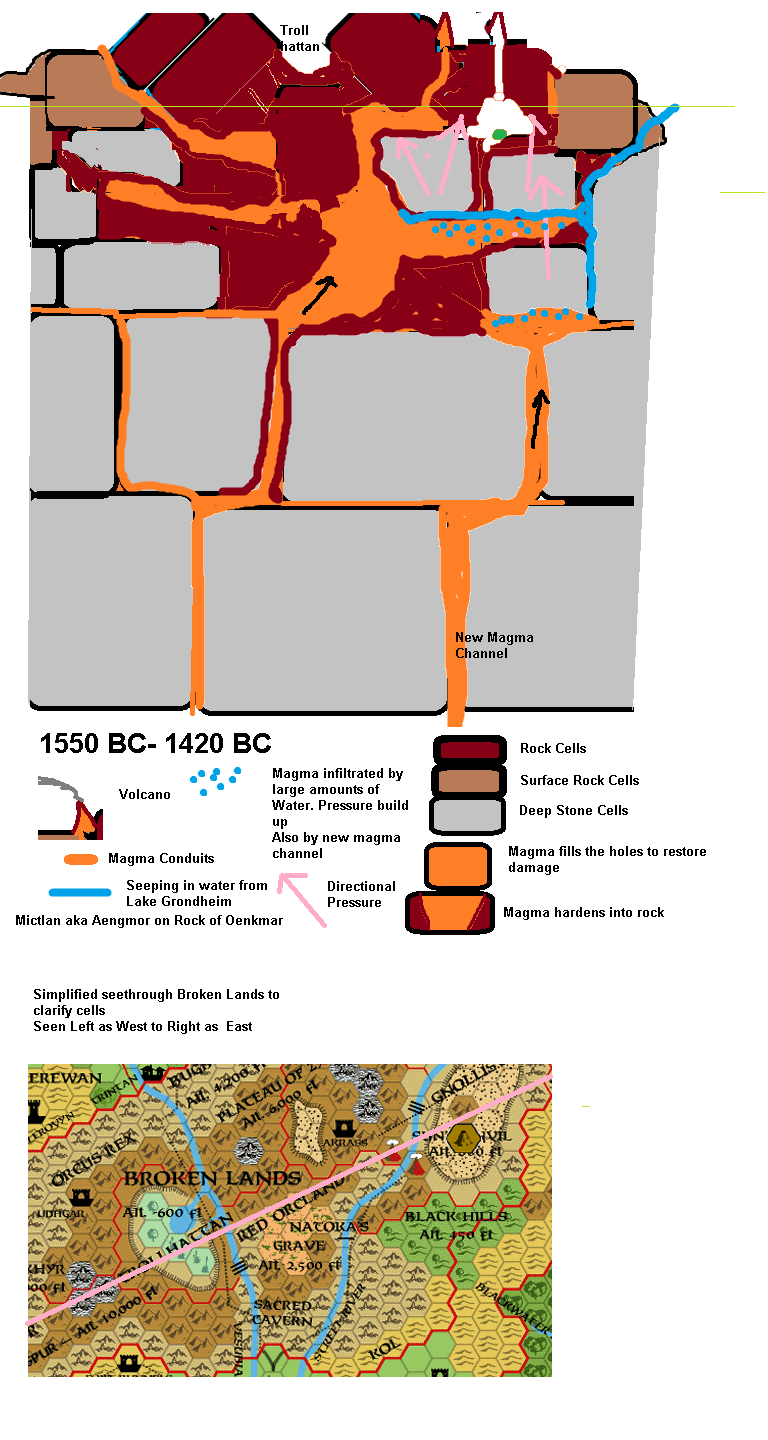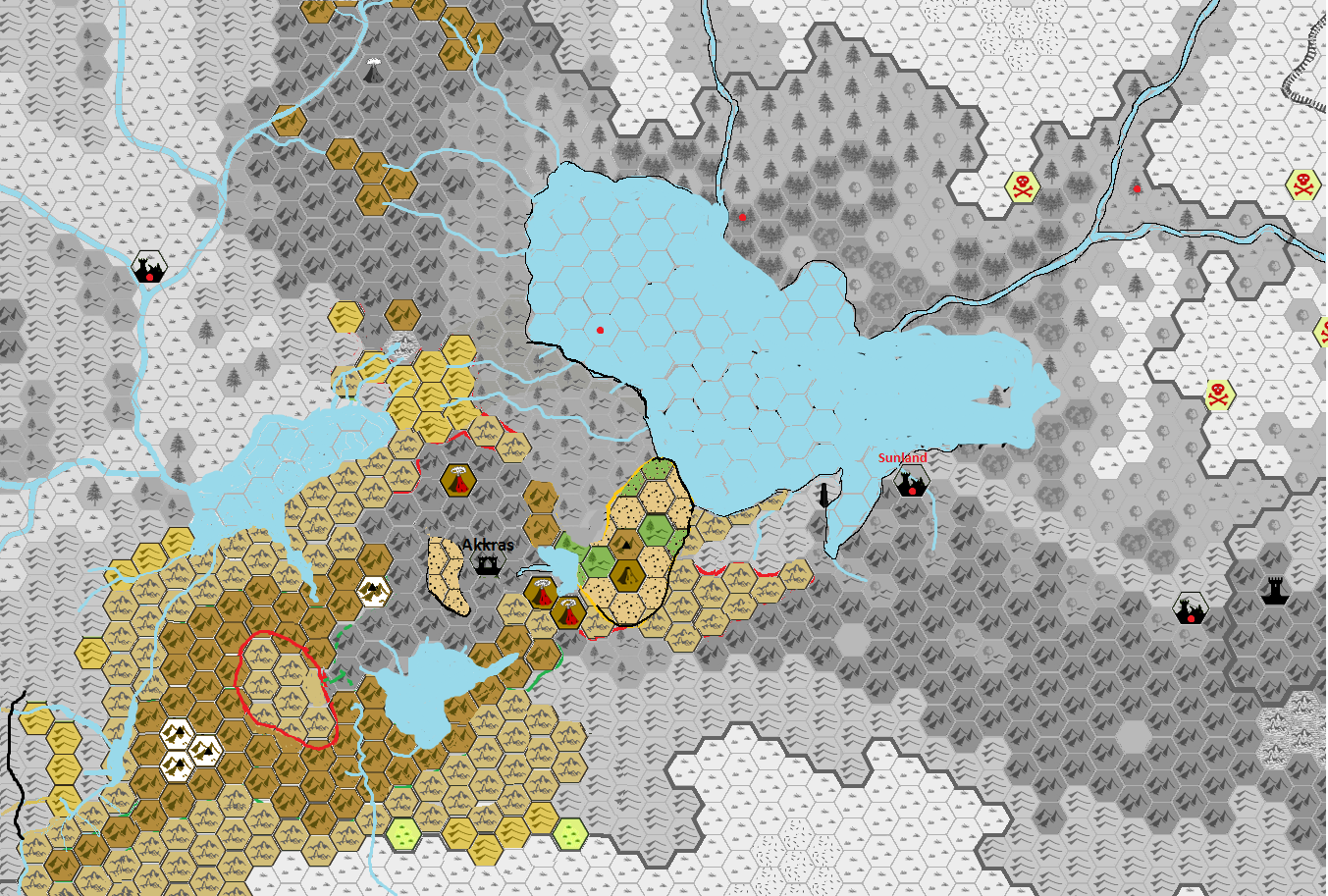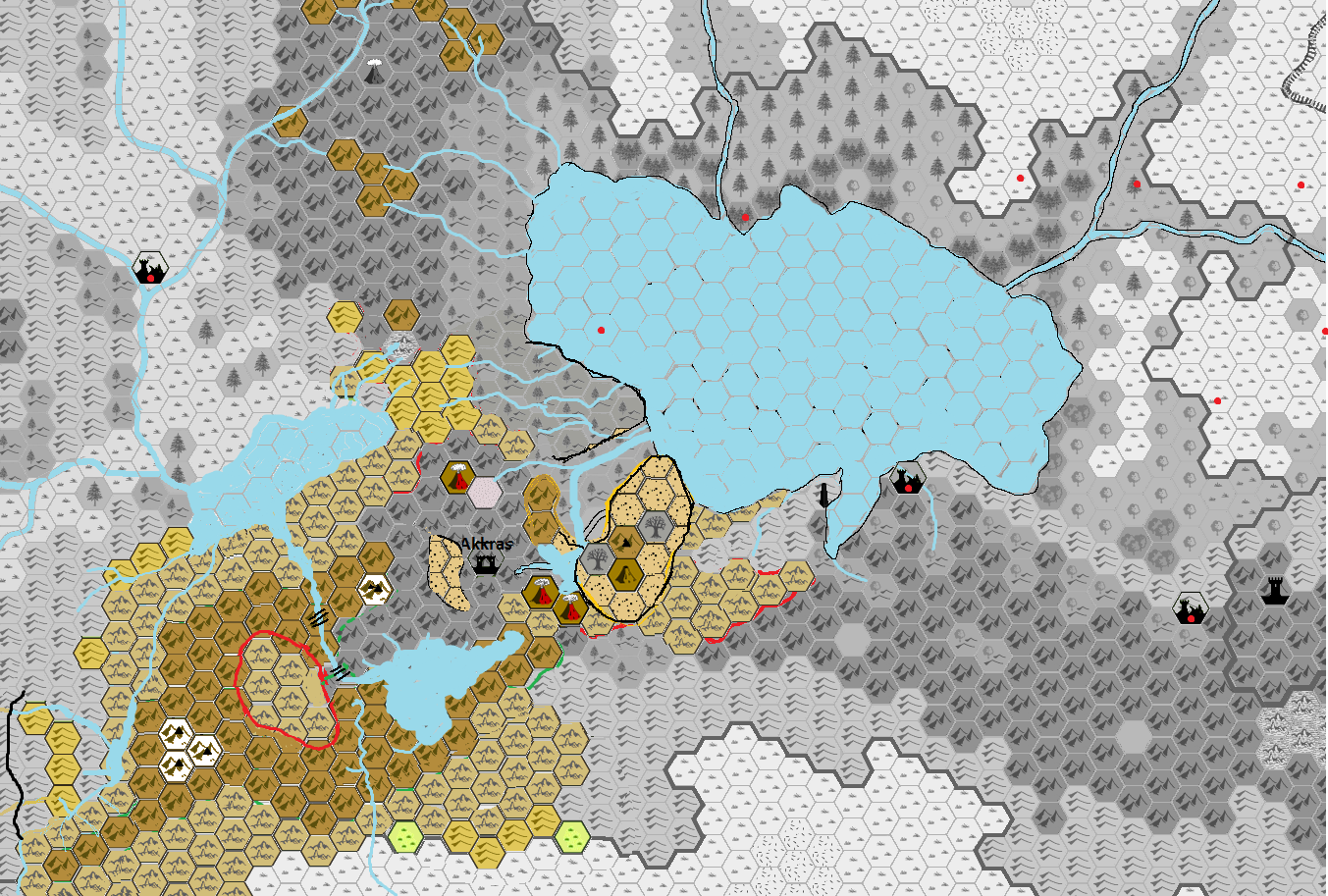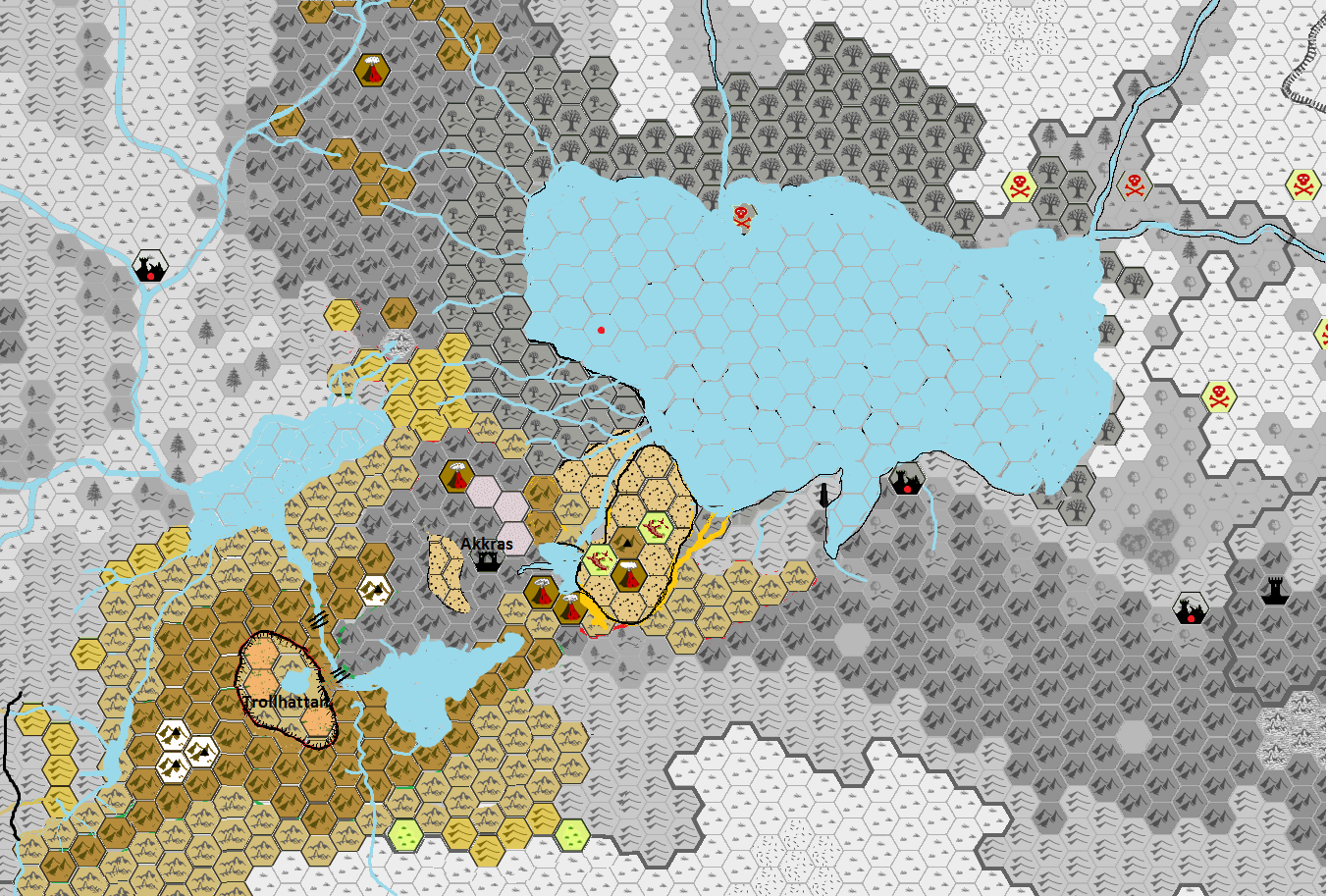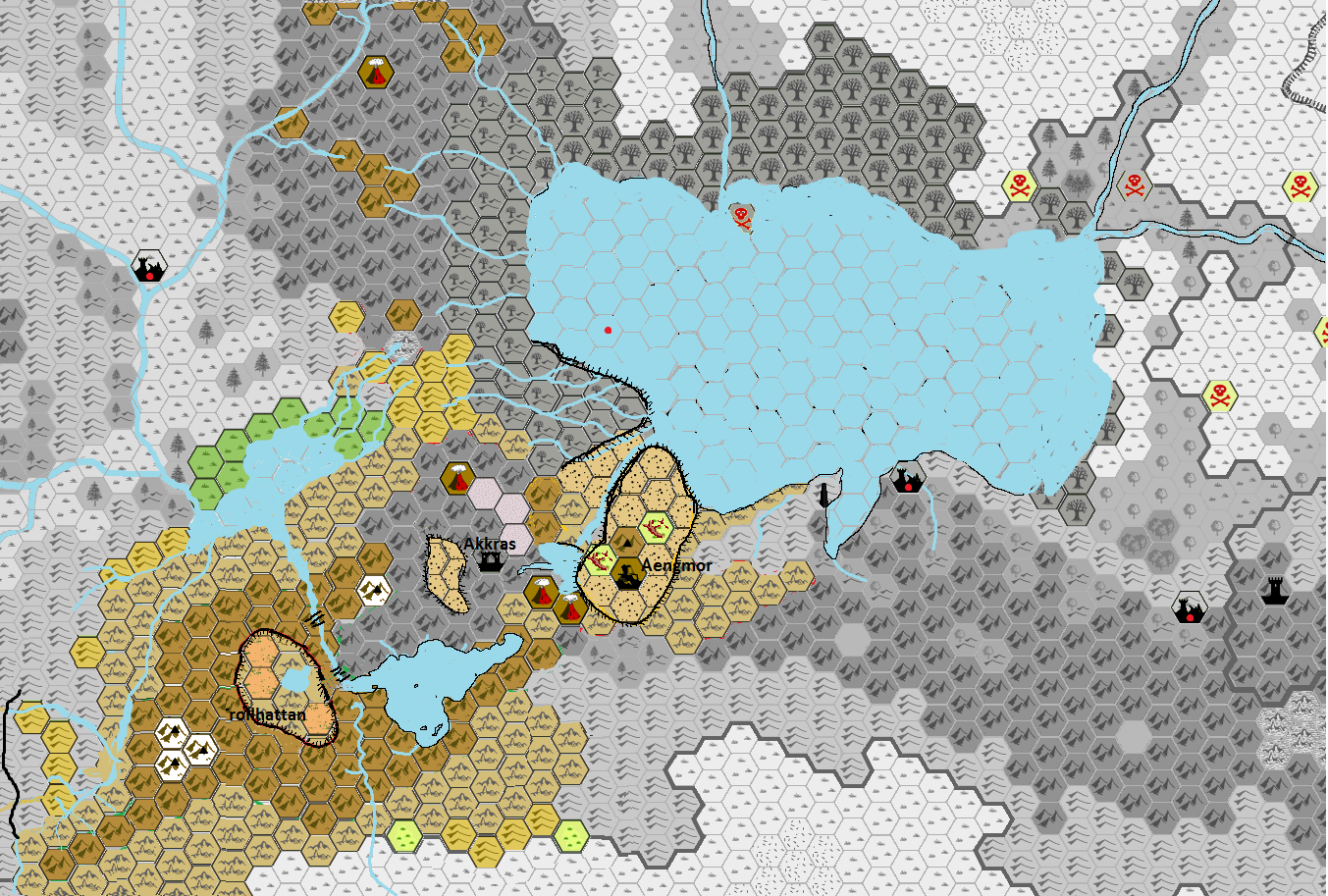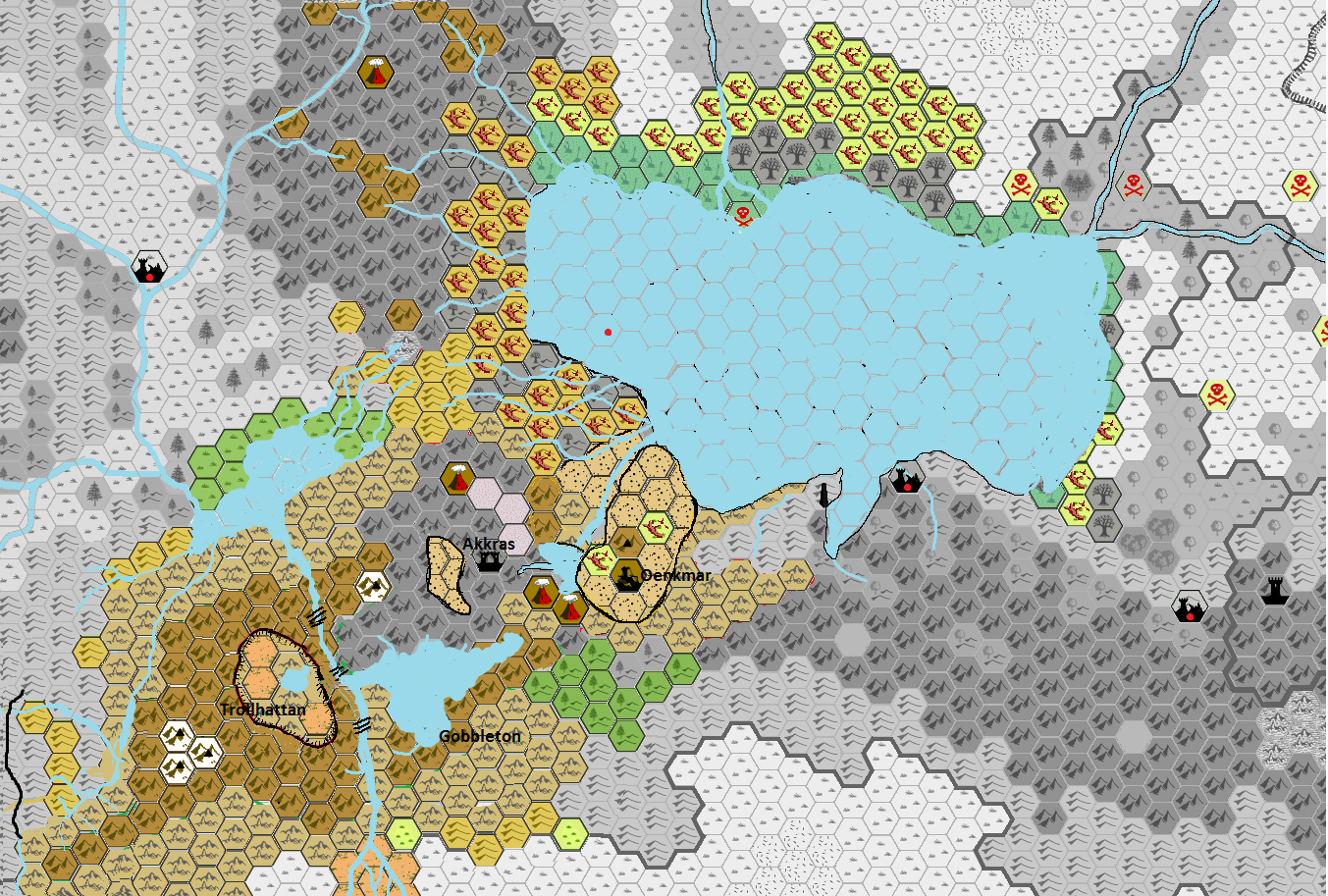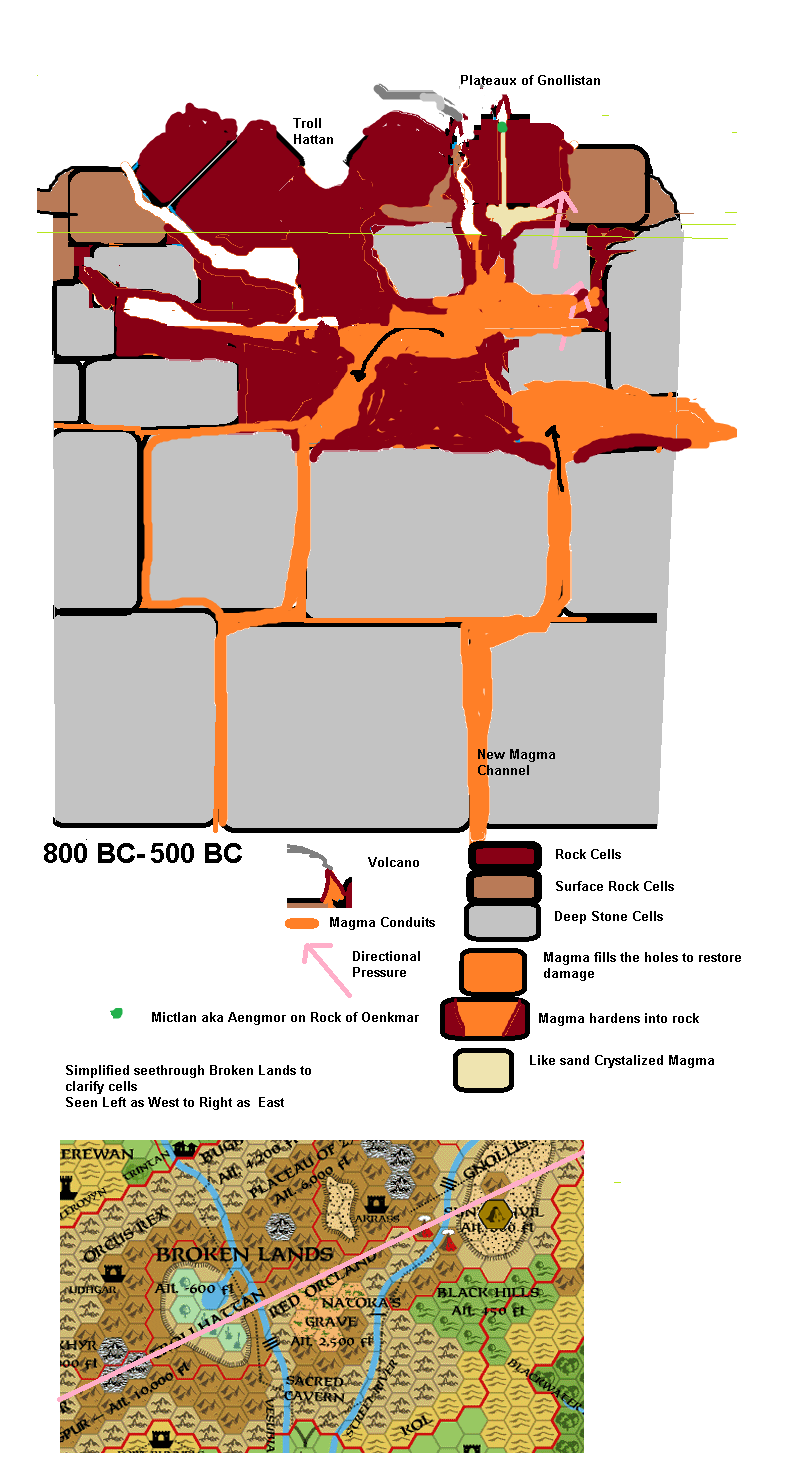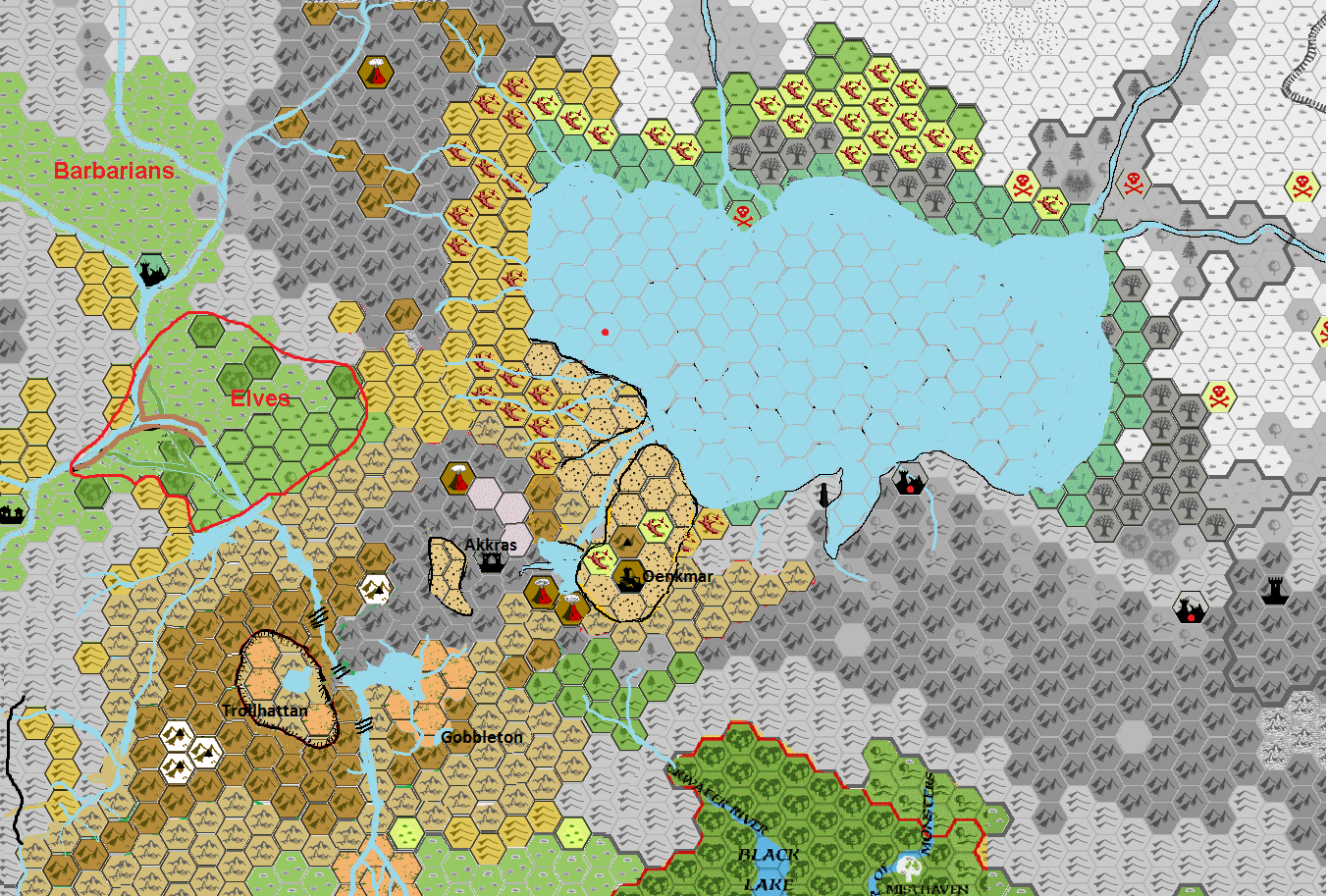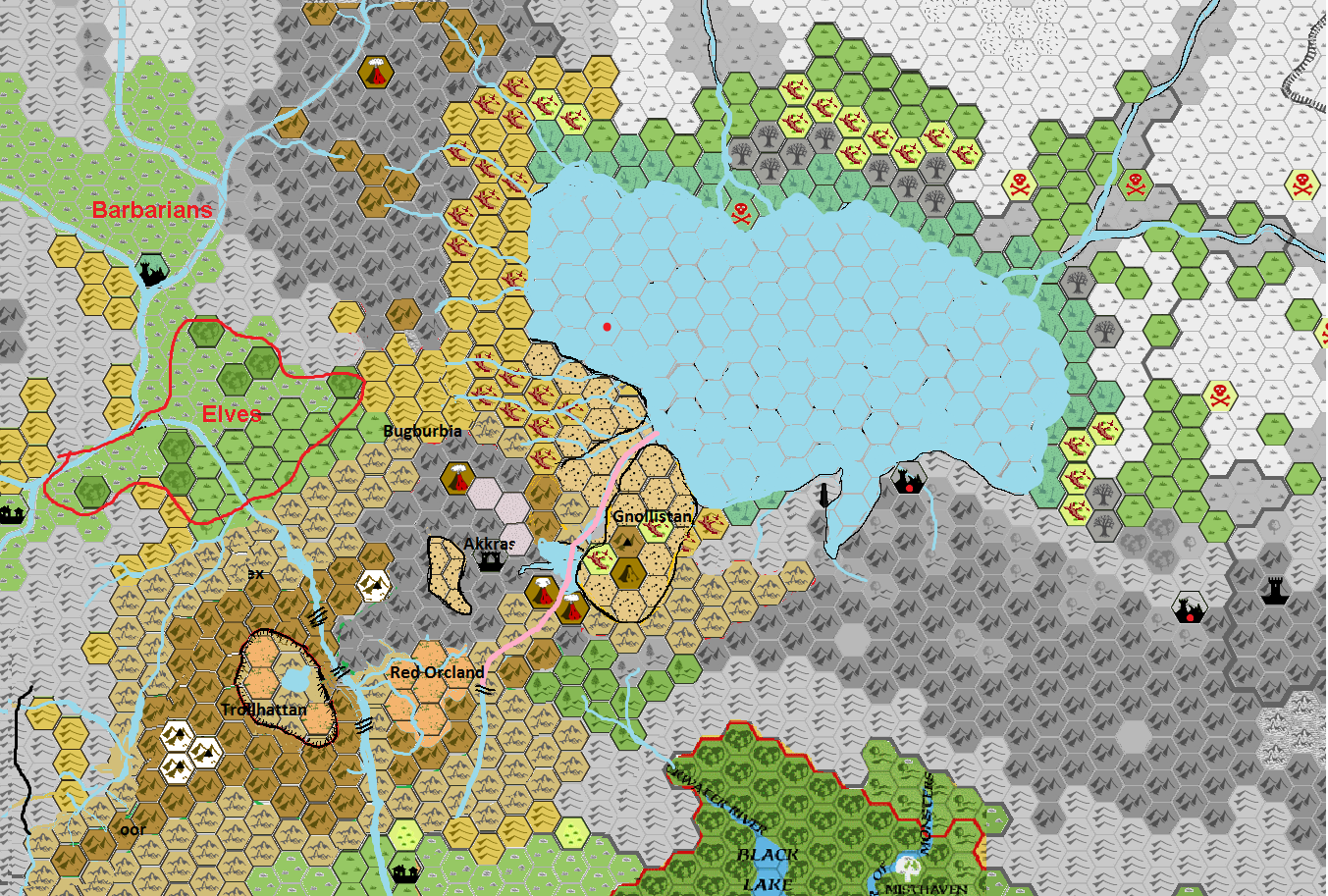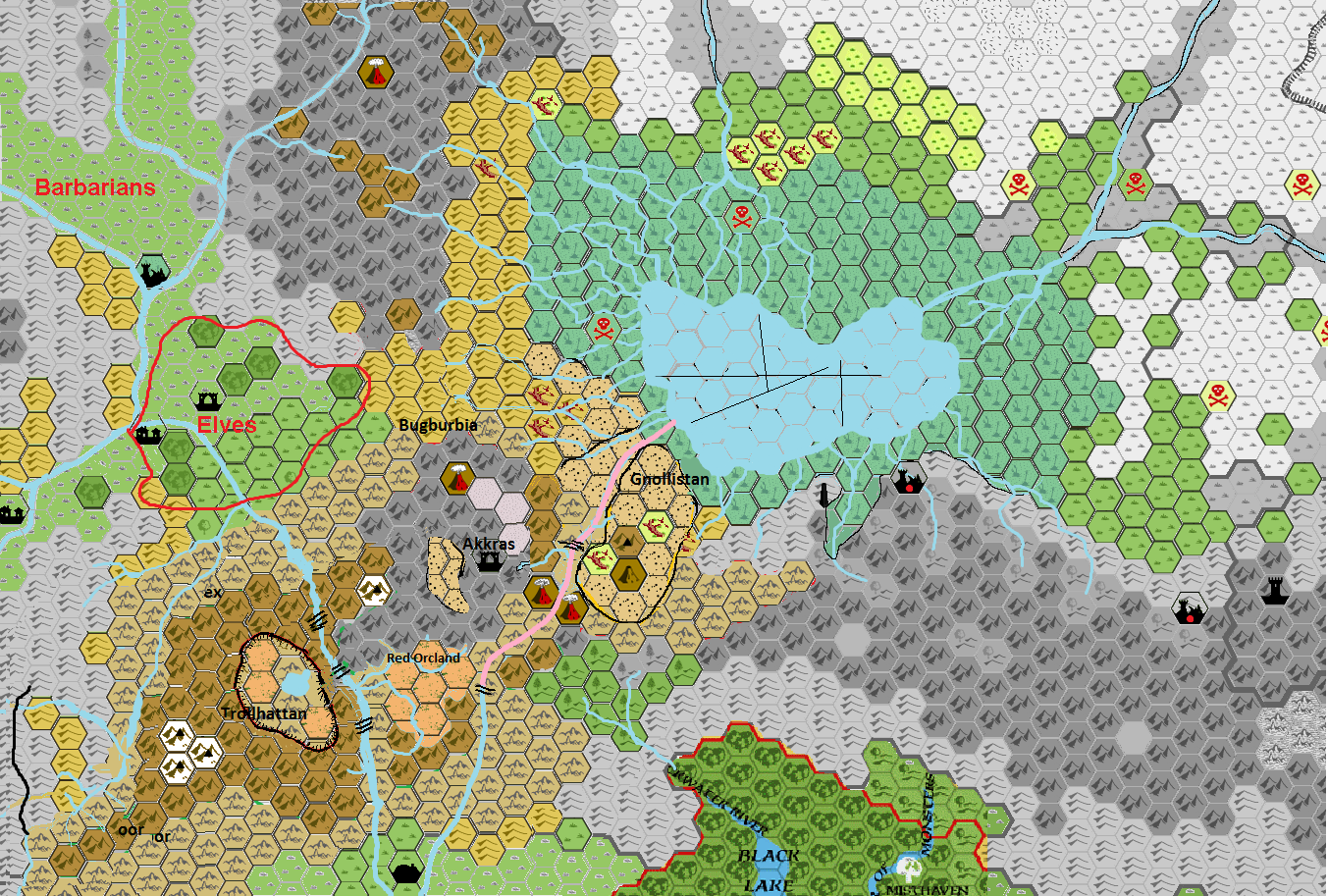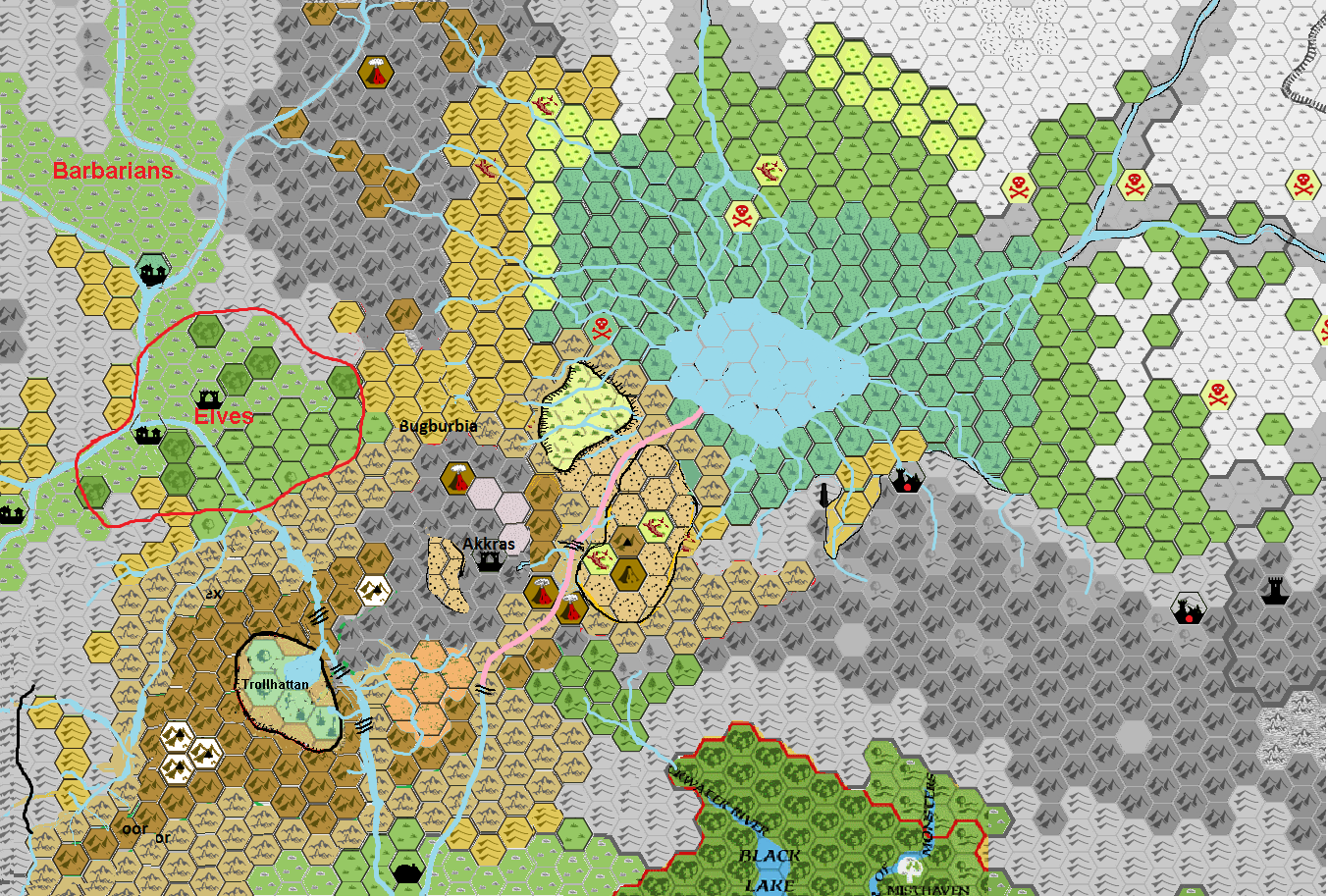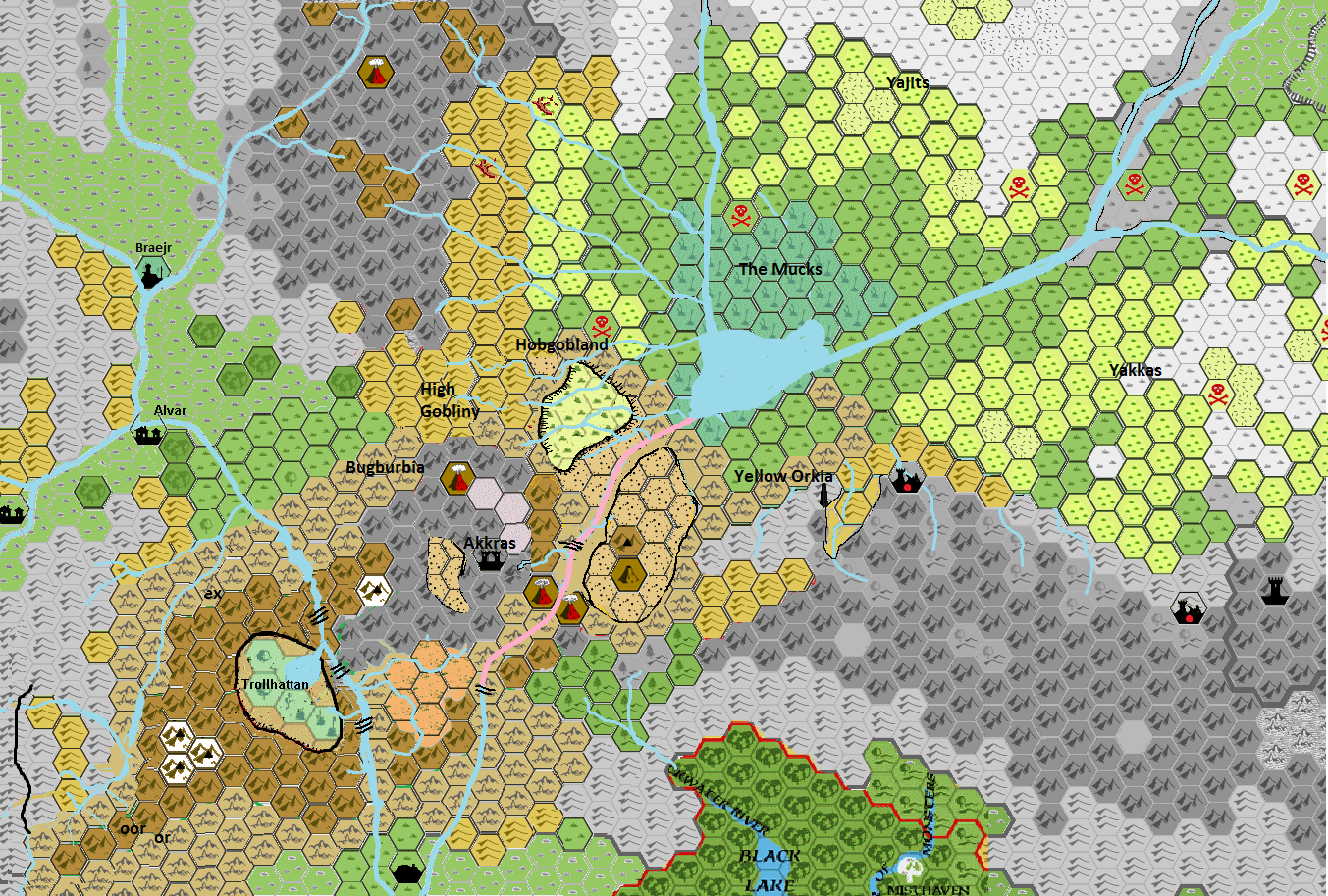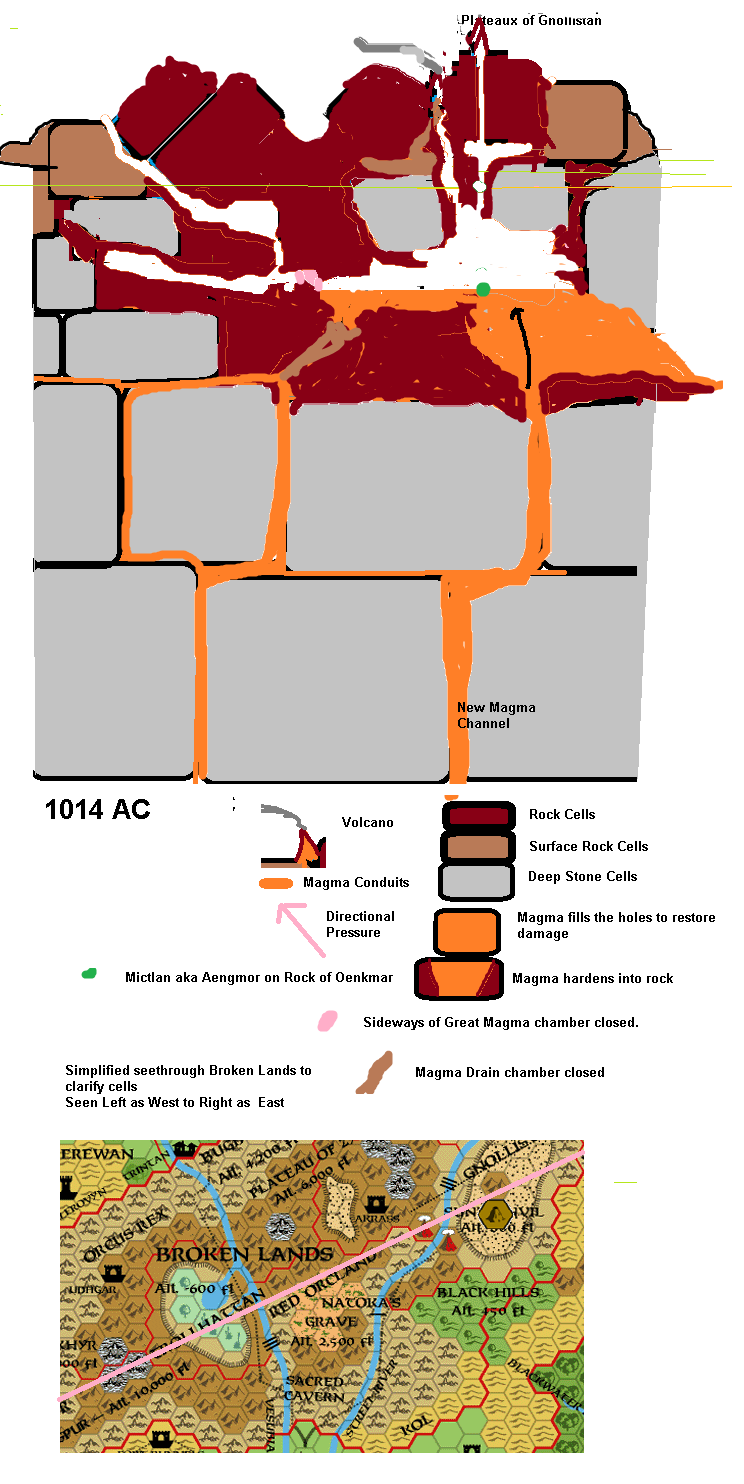
Geomorphological History of the Broken Lands
by RobinGeomorphological History of the Broken Lands 1
As told by Mergrath the Dwarf Druid (actually Earth-Elementalist). Penned down by Professor vander Klil who was present at this interesting lecture.
Mergrath, twisted his beard, rubbed his bare feet and thus removed some caked earth from his feet hair. He looked down upon his scholars, and without hesitation began.
In my lectures about the Megalith, the living planet Urt, the history of the Broken Lands region will explain many things happening with the cells of the Megalith.
(Read Megalith 1, Megalith-2)
As some of you might have learned in accessing other worlds, is that most planets with active geological processes have, what we call, tectonic plates; A crust actually floating very slowly on the internal magma and molten more metals that actually compose most of the planet.
Mystara, as being a living planet has no tectonic plates, it has cells instead. Where tectonic plates slowly move on the molten mass and fold against, over-under and alongside each other, thus creating mountains, depths, volcanoes, earthquakes and similar processes, Mystara functions differently. Although same said effects are produced, Mystara’s cells only sink, raise, twist, or rotate, expand, shrink, or most rarely implode. Some other effects like temperature increase or decrease can happen too.
The different rotation effects do cause earthquakes, but rarely as destructive as on tectonic worlds. Oh yes, it may be destructive to the creatures living on the surface, but to the planet itself, it is a mere shedding of skin, a blemish, a zitt growing or expanding, an itch.
But as we have almost no effect on tectonic worlds, we do have effect on the cells of Mystara, especially Immortals, or our magic. We all know of the Plateaux of Atruaghin being raised by the Immortals, or the impact of the meteor in the Great Crater south Glantri. But even here we can see the difference of the tectonic versus the real living world.
I do say living, even if there are many sages who say our Urt is dead or extremely slowly dying, but other sages say the opposite. Either way, the processes are part of living processes, and as such I call it Living World (even though there seems to be proof of these processes changing. More about this later.)
Back to the Meteor; Mystara has a powerful Skyshield, a biological magical process that functions similar as the spell protection from missiles. The speed of the incoming object is instantly decreased or reflected and only sources with internal magic can penetrate that shield. As the nearby fifth planet did explode some time ago, many debris of this magical world floats around in space, some of it reaches Mystara, and as thus penetrates, though greatly reduced in speed, the Skyshield, hitting the ground below with greatly reduced impact.
A meteor of the same size would normally have destroyed ALL life on a tectonic planet, as the meteor would have slammed deep into the tectonic plate, surfaced explosion magma, spreading an impenetrable dust cloud, and bombard the rest of the world with returning meteor and planet debris. Survival would be nigh impossible.
Mystara on the other hand has the Skyshield, AND its cells. Not only is here the speed of the incoming object greatly reduced, the surface (or skin) cells are the secondary defence. With the impact of the Glantrian Meteor, we see that only a few cells exploded, a powerful wave of energy caused an earthquake several cells further away, and expulsed matter was spread within the general same region, even the dust cloud was less intense than it would have been on a tectonic world. And you should be happy about this, for if Mystara was no Megalith, we would now be dead, or dying, buried, burned or choking dust, and then die slowly because of heat, or food deprivation. This impact clearly learned us much more about the composition of our world.
And as such we can explain many other things, among so…The Creation of the Broken Lands.
Some dwarves twisted in their seats, and between the snoring of the sleeping ones, some muttered foul words of Shadow Elves or Humanoid scum.
We must go back in time, back to the age before the Great Rain of Fire, back to 3000 Before Crowing.
Several sages have discovered that the dominant nation of Blackmoor had a great colony here on the continent of Brun, in a temperate region not very far from the edge of the polar cap of that era. The Azcan and Oltec Empires to the East, and a Draconic empire to the Northeast. And South East, the ancestors of the dwarven race, before Kagyar moulded us into his image. A lot of minerals important to their technomantic energy could be located in this region, and as thus were of great import of the growth of both the Empire and the region itself. The region was accessible over the Grasslands we now know as Ethengar, or by using their technology to fly. Some even say they had tunnels in the air where tubes could fly, in which you sat. Nobody knows for certain, but the Ruined city in Fenhold seems to be connected to this.
As you see in this map…I drew a square over the region we discuss…which is the region we will learn to now as the Broken Lands.
Yes, it was a fertile region with forested hills, some mountains, and a large lake. No culture of any race would disdain itself from here by choice.
Mergrath scraped his throat, paused a moment and then continued. Still many dwarves were attending…consciously.
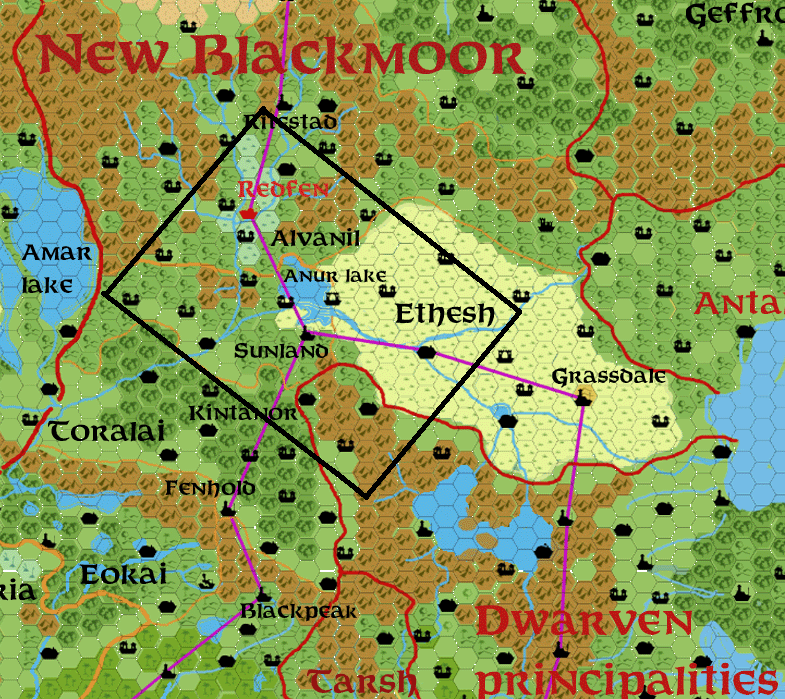
Geo fase 0 3200 BC - 3000 BC
Then we had the Great Rain of Fire. Some unknown technological magical devices exploded in such a fore that it tilted the planet., and changed its polar axis. The region of Blackmoor was depressed by the power and cells imploded, the ocean swept in and doused the flames, which otherwise would have caused greater harm. The dust and debris covered most of the world, and caused darkness, greatly diminished harvests, and the rotting plague we all know in our history. It also caused a great temperature change, the amount of snow (with ash from the explosion) covered great areas of the world.
Of the map here the grey areas are the limits of the thickest snow layers.
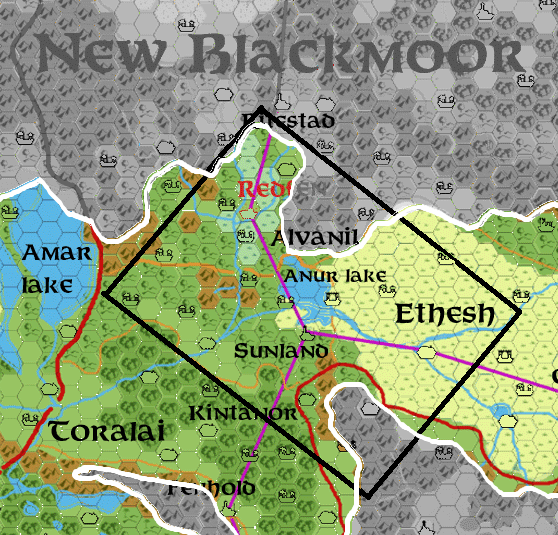
Geofase 1 3000 BC - 2700 BC
Of the information gathered by these sages there was created this large scale map of the region. Yes it looks differently than our world, but do not forget that the world was tilted. As points of reference, Redfen was on the location of current Glantri city and the mountain spur in the lower corner are the Dwargate Mountains.
Beastmen, the ancestors of the current humanoids, unhalted by the fallen Blackmoor Empire, quickly took over the region, changing rapidly by the Rotting disease in a multitude of forms, we now know as the different humanoid races.
Here a more detailed map depicting the region. Clearly can be seen the huge area covered with hundreds of feet of snow.
The human race, were it survived returned to a much more primitive state. Their former cities ruined, slowly crumbled down, and within the upcoming centuries, most of the completely disappeared (either by nature, erosion or plunder). Some Fairies tried to withstand this hard era and had a region they claimed as theirs. The Beastmen slowly filling in the niche of disappeared humans, elves and other races, were afraid of their magic and stayed away moving north into future Glantri and south into the Hills of the Streel Plain.
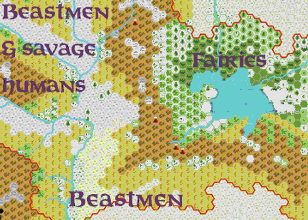
The northern part of the Known World was probably covered by snow and ice all year long, making food scarce and life quite difficult. All this snow has weight, and this weight depressed the cells. Etthengar and Northern Darokin were lower in that era as currently. When the snow later melted the ground slowly rebound, as the cells expanded again.
Back to the Broken Lands, the next thousand or so years, the world calmed down, the dust clouds dispersed, and temperatures rose, snow and ice melted, new rivers sprung and lakes filled. The following map is the region in the year 2000 Before Crowning.
To explain the difference and the coming changes of this region we overlap both maps and create a new one. Now it becomes clear where what was and is. The dots within the hexes denote the state of the region 2000BC being different from that currently. White were glaciers, of which only a few, much decreased in size and volume may exist.
Brown dots were mountains, very familiar to us.
The words “…were mountains…” caused a stir under the suddenly active dwarves. Mountains disappearing, that’s a horror. “Silence please” Mergrath continued. “I will explain later”.
Beige dots were hills in that era, as light yellow dots were fields, acres, or flatland. There were no forms of broken land. Green dots were forests. As you study this map you can see great differences between today and then, but this did not happen all in once.
Then came the year 1700 Before Crowning. We all know how inquisitive, strange, curious yet dumbfounded elves can be in reflection or use with machinery. The may know a lot about plants, nature or even magic, yet they are often so alien to this world, that they seem to be no part of its real understanding.
The great lake, almost an inner sea, formerly known as Anur Lake was now part of the Grondheim region, and as thus we name it now Lake Grondheim, although the real name of that era is lost.
The dwarves cheered, and applauded. Some even brought forth flask, and poured it in their gullets as a way to enlighten the joy.
“Please, please, keep your attention” Mergrath said smilingly, trying to prevent the lesson turning into a dwarven bar feast.
As I said it was the year 1700 BC, but to explain, we actually have to go back way to the Era of Blackmoor. It was in this time the scientists (as mages were called then) discovered the cellular structure of the world. And it was in this age, druids and elves surmised that the world could well be a iving creature. Yet no signs were known to link to lifesigns, so further investigation was needed.
The humans, dwarves and yes, even elves worked together to create an immense machinery called the RCC (Regressive Colliding Collector), around the few underground cells that provided the energy they craved for.
At several locations they erected huge factories of machinery, connected to each other in a large circle around these.cells. The huge rock cells above holding the energy within, and nearby volcanoes enabling the energy being channelled outside to be harvested. Further details of this machinery is lost in time, and that may well be a good thing too.
As technology and magic fused, powered by the knowledge the Ancients brought forth when their vessel crashed on Mystara, the world soon suffered from pollution by this technology, and the nature minded people and elves desired other sources of energy, better for the world but without pollution. This was difficult, as the world was often in war, The humans versus the Beastmen, nations against nations, all to acquire the technological might Blackmoor possessed.
Then some scientists discovered that on some locations in the world the ground possessed great power generated by itself. As if this living planet had something like muscles, able to generate power to do things. This power could maybe harnessed and used. There was only one location that was easily accessible…The region West of Anur Lake…the current Blackmoor colony of Brun..
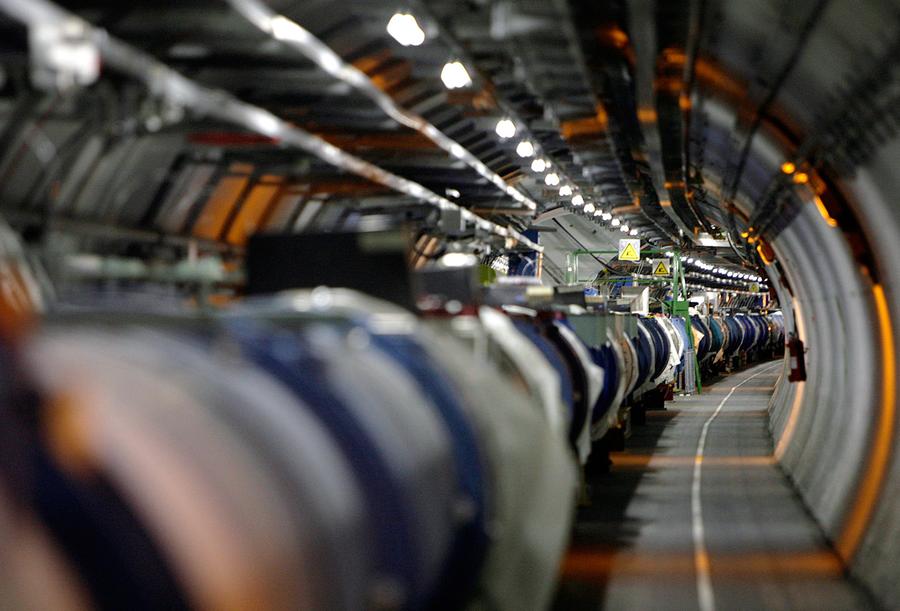

3000 BC - 1700 BC
The machinery was still in its try-out fase, when the Great Rain of Fire disaster struck. All over Mystara machines exploded that were connected to the Technomantic reactor, many people perished in an instant, cities, and villages were blown away in mushroom clouds. Why mushrooms? We really do not know, maybe the technomagic worked like a fungus, a disease, at least it brought a great disease.
At the RCC machine, only the outside controlling towers suffered from the explosions, the machinery below survived, intact, and active. Yes, active, the machines continued working, unchecked, uncontrolled. Some say that special golems called S-bots and U-bots kept all things as they were, but none of these were ever recovered, or recognized as such. For 1300 years the machines hummed, slowly storing energy, continuously created by the biological effects of the cells themselves, normally used by the organism, intended to be used by the Blackmoor culture and stored in huge special vats, called accumulators.

Geofase 4 2300
The Elven King Atziann, who maybe was in hiding with some loyal followers, discovered the ancient RCC machinery. As being technologically inept Elves, they wrongly surmised it was a weapon of some sort, and tried to use the Blackmoorian device to destroy the humanoids. Pushing several unknown buttons, and altering several levers, they activated the machinery.

Before 1700 BC, the Great Horde conquerred the steppes. King Loark settled in the region west of Lake Grondheim. Some say he was influenced by the Mighty Troll Quen there, others say differently. There seems no real proof of either case, however. The elves were enslaved by the humanoids as were the Ethengarians.
The plan backfired, the last we know is that U and S Golems tried to save what they could, and Atziann and his followers were forced to escape underground. It was too late; What did actually happen?
The cells surrounded by the RCC device released all stored energy back into the cells were the derived energy from. This sudden instant backlash of energy caused the cells to chemically overload and explode.
A local cataclysm rakes the region, and buries the Great Horde.
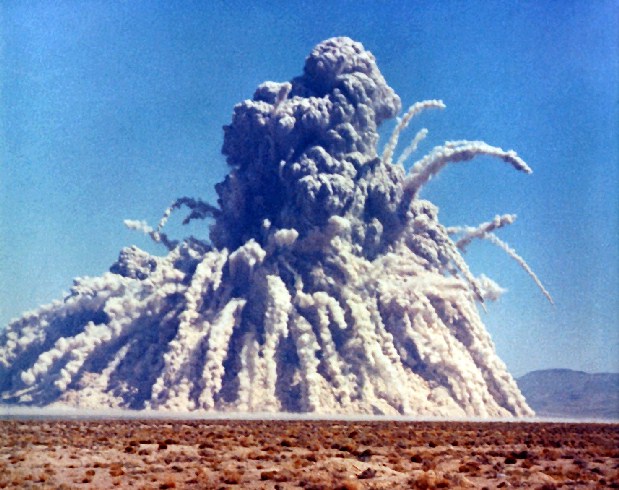
The Great Cataclysm of 1700 BC as seen from Ethengar, 200 miles away.
1700 BC – 1550 BC
The Red and orange dots on the last maps became Broken Lands. The Green dots became Mountains. Some minor areas had lesser effect and became hills or barren plains.
The explosion caused the central cells to collapse. The main cell complex, which was located right underneath today’s Trolhattan, was lierally destroyed. (red circle with red dots).
The blast created a force directed outward of the region, pushing the bordering cells outward, rupturing their connection, but also lifting the area upwards. This power was greatest upwards in the North, west and Southern Region. (green lined area with Green dots).
The mountains existing in the North East and East could not endure this and two large sections collapsed into itself. Where there were only hills or flat land before, the force pushed the area up, and this pushing continued as the heavier Rock cells on the surface start sinking, as they lost their support, pushing the lower and other cells next to them away.
The two complete mountains collapsed and disappeared. All this being hidden from direct view in an enormous cloud of dust and sound. (red lined area with red dots.
This whole breaking up caused further side-effects lifting and pushing territory, that it became Broken Lands (orange dots)
At the same time magma comes from below in an attempt to heal the wound thus creating more upward power.
The alteration of the region caused the Isoile River from the region of today Glantri to become blocked, slowly creating an ever expanding lake. This lake pressed itself against the new broken lands in the south of future Ererwan and Belcadiz.
Slowly more pressure build up by the magma coming in from below, loosened the remaining upper cells. The body of the Megalith worked clearly to heal this wound.
We now know that dust of fresh magma used in potions of healing, brought the power up (from 1d6 to 1d6+1).
The devastation seemed complete, but actually the change was just beginning.
The region of the collapsed cells was terrible. Through the broken Lands, deep within this crater, noxious gasses, killed all that was still living. and even petrified them, similar as fossils.
Meanwhile, the magma started slowly to solidify.
The Great Glacier on the Southern end of the Collossus Mountains, north of the Broken Lands, starts to melt, and two new rivers empty in Lake Grondheim. On the Western side the same glacier helps filling the new lake in Future Erewan. In 1691 BC the lake already covers an area of more than 200 square miles, and there does not seem to come an end to this.
In this same year the pressure from below becomes thus strong it slowly, but inexoribly lifts up a whole region of mountains, creating a whole new Plateaux. This area will later be named South Gnollistan. And holds three active volcanoes.
The old fortress of the Troll Queen (current Akkrass) is slowly pushed up also, but further sustains minor damages.
Otherwise the old Blackmoor town at the rim of the rising Gnollistan Plateaux suffers severe damages.
Water Being blocked from leaving the mountains come together south west of fort Akkrass, and create another lake in the region later to be named Red Orcland.
The Streel River is now only fed by a single source (and some minor sorces elsewhere) in the new mountain pass East of the crater of implosion.
As the Isoile River (Future Vesubian River) did no more connect the Streel River, it became of much less influence to the nation of Darokin, much less water passed through and often he river fell dry in summer. Side rivers went even north on the Glantrian side and further filling up the Erewan Lake, effectively enlarging it to a surface area of no less than 850 square miles. The water slowly gained such a level, it found a way into the new broken lands.
The new mountains have reached such height new glaciers are formed on several tips. Between three of them a new valley, comes to be. This valley is the Later Valley of Khyr.
The erosion caused by the dissapearance of the glaciers of the Collossus Mountains caused the britle rocks of the broken lands between Ethengar and Glantri to become hills. The broken lands created on the former mountains betwee Darokin and Ethengar, had no glaciers and as thus suffered less erosion.
The volcano Kalazyrd (north of the Zyrd Plateaux) becomes active and up to our current date never stopped. This was caused by the geological activity below. Kalazyrd is an ash volcano, and its poisonous ash is blown to the by a wind that is almost always southbound due to the collossus Mountains. Even the Twin volcanoes were still active, spuwing fort supplies of lava, that hardened and increased their height.
Specific locations in Ethengar seemed to become attuned to Magic, by the amount of dust caused by the Region.
Further away, the destruction caused a breach between the spirit realm and the Prime Plane on the only mountain of Ethengar. The new magic attracted the falling dust towards it, and as thus saved Ethengar from eternal deprivation of a fertile ground. The region became known as the Black Sands, and the various other magic locations seemed to become sources for magic users or Hakomon.
The region of the today Yak's Spur/Orgemoor, starts and continues up to today, a slow but steadily rise. This not only breaks of the old Vesubian river, but with the uplift of the area, creating a sort of Plateaux, it locked water here into small lake.
1550 BC - 1420 BC
However, the volcano on the Plateaux of Gnollistan ceased its activity, and seemingly died. The large "cork"that closed the crater falls down in the now empty magma chamber, and will later become the "Rock of Oenkmar" resting on the floor of the small upper magma chamber of the dead volcano.
Lake Grondheim also enlarged, by the several new streams from the melting ice caps and glaciers of the Collossus Mountains.
Water from Lake Grondheim seeped in through the ground, creating enormous pressure as it became steam. Not only created this the further heightening of the Gnollistan Plateaux, but around it a new feature became prominent, making the region difficult to traverse to; Hot Steam Vents.
The region of today's Ogremoor has been uplifted that much, that small lake flows down north through its old riverbed where it earlier flowed south. The humanoids call it "The Returning River". It flows back into Lake Erewan, fed by the small creeks in the mountains. Lake Erewan slowly pushes itself, into the Broken Lands.
In this era the Shadow Elves discovered Mictlan, conquered it, erected a much larger pyramid temple over the older Mictlan Temple, and radically enlarged the city in a period of fifty years. They used the name of their former nation, Aengmor. It was 1352 BC. The Elves could not rebuild their nation however, as the region was not fully settled from the earlier happenings, and ravaged by many earthquakes and volcanic eruptions.
Within the area of future Ogremoor (actually named after Aengmor, but the Ogres wanted an Oenkmar by themselves), the area slowly stabilized. In the underground chambers the magma retreated, and never returned as the inlet was blocked by a basalt plug.
The Erewan and Red Orcland lakes continued to fill and expand, As did Lake Grondheim, by the increased wet weather in this era. This was probably caused as a final stir of the destabilization caused by the tilt of the planet, and the few disaster following, before it stabilized in normal weather patterns. Most dust now settled, and the world prepared itself for a clearer sky.
Lake Erewan, pierced itself through fissures into the mountains North East of the Trollheim crater, plunged down into Lake Red Orcland, further filling it up. With this waterflow, through a small channel, erosion was imminent, and the fissure opened by the Erewan Lake, widened, and covered the bottom of the Red Orcland Lake with a thick coating of sticky mud.
This also caused Lake Erewan to decrease, and leaving behind a very fertile light clay. Soon nature will take over and covers the edges of the lake with grasslands. The humans of the region greedily made it into farmlands, and former fishing settlements, slowly become farming centres. This can still be seen, as upturned wooden ships, have been used to make housing and temples.
Within this underground chamber refugees from the Hollow World Azcans created a new town Mictlan on the rock as this is the only flat and sturdy surface to build upon. A small temple and several structures are erected..
The plateaux itself continued to rise, and the water that became blocked, still enabled enough moisture to let trees survive...for now.
1420 BC - 1290 BC
The elves could not enjoy their city for long, as already in 1290 BC, a mere 62 years later, the inflow of water from lake Mictlan renewed the inflow of magma caused by the build up of pressure from below. Clogs in the flow directed most pressure to the larger magma chambers in the North East. With this, magma surrounded the Rock of Oenkmar, lifting it high up, back into the crater of the volcano. The only thing the elves could do was fleeing. Several sources claim that an Immortal named Artzanteotl, caused this to happen, to further increase the power and input of humanoids on the world. With the Elves gone, the input of the humanoids on the region greatly enhanced.
The small poisonous lake created earlier north of the Twin Volcanoes breaks over its edge and starts to cause effect in Lake Grondheim. As the flow in the Lake seems to be East bound, the poisonous acidic water starts to affect that region. Many plants and animal life seem to perish, or adept.
1290 BC - 1269 BC.
Another Volcano becomes active, further up north the Collossus mountains, south of Mount Skullhorn. This volano, later named Thanos Breath, exhumed great amounts of noxious gasses, and acidic downfall. this greatly affected the region of Ethengar West, Glantr, and Lake Grondheim, which took the brunt of the damage. The forests around the lake died. and the region was abandoned by most animals, humans and even humanoids. This may be the reason for the attacks by orcs into Darokin, as their own territory became less usable.
This massive eruption took away a lot of pressure below the Broken Lands, and the higher magma chambers began flowing back down. In this proces the magma underneath Oenkmars Rock started to solidify and crystalize into a fine sand-like substance. The Rock of Oenkmar was still stuck in the shaft of the volcano it was originally the "cork" of. The small upper magma chamber was fully filled with this crystalized sand. This "sand " was later traded and was the prime source for the dwarves who invented glass. This process later became simpler, and open to use by all races, but the source lay within Dwarven hands and this region. Many glass artifacts will proof this. This trade and the hidden Elven knowledge ignited the growth of the influence of Oenkmar.
The always active volcano Kalazyrd, increases its activity and yield of ash, greatly altering the region, as the mostly southbound wind draws all the ash falling down in the same area. A plain of Ash is created, and continues to grow up to this date. When not blown South East, it tumbles down the hills, packed up in layers of dust, ash and debris of several feet thickness in the areas of High Gobliny and Bugburbia.
1269 BC; Ogres settle in the Broken Lands after suffering great drought in Sind.
Mergrath viewed the room, several hours had passed, yet stil most dwarves were awake. he was content, but decided he no longer could keep their attention.
"This was all for today. If you want to learn more return tomorrow. For those hungry, we have drinks and food prepared in the halls in outside. A curtisy of my own".
The dwarves cheered, and readily, a bit stiiff, left the large room.
Most would return tomorrow, maybe a safe spot to sleep, or an interesting lecture, who knows.
Sources; 3050-3000 BC, 2300 BC maps By John Calvin and Sturm
Art; machinery_factory__underground__by_yoyojun-d6hne5l
Picture; Hadron Collider Cern http://cdn.theatlantic.com/assets/media/img/photo/2012/07/the-fantastic-machine-that-found-the-higgs-boson/l04_31052663/main_900.jpg?1420515747
Picture; Nuclear underground explosion http://cdn.zmescience.com/wp-content/uploads/2015/07/sedan.jpg
Geomorfological History of the Broken Lands 2
As told by Mergrath the Dwarf Druid (actually Earth-Elementalist). Penned down by Professor vander Klil who was present at this interesting lecture.
The noise in the cave was overwhelmed by rumbling chitter-chatter of the dwarves attending the class. There were more dwarves than the day before, so Gaston assumed Mergrath struck some sense into these stubborn dwarves. It was as if the dwarf to his side read his mind, and his bright seemed to dance with fire, when he reacted; "Lots o'Dwarves indeed, more than day before, indeed, interesting..indeed, but why a common mage shows interest I do not understand". Gaston responded; "Not so common as you might think..."while handing him a gourd of Dwarven mitaq .."A sip in friendship and learning, perhaps?". That was something the dwarf could not resist, it was not often that a mage understood the taste and joy of mitac, let alone offering some. "Mitaq, nice...Salechaam is the name" "Nice to meet you Salechaam, my name is Gaston vandew Klil, and I am hewe to leawn, how ouw wowld functions"."www??" "eh..yes, you point to my speech impediment", and lifted his upper lip, revealing several teeth missing, "...an "accident" so to say, I might explain mowe latew undew a meal, maybe a job offewing?" "Ya know how to charm a dwarf Gaston, that date is set, I might be interested in da job...depending on da pay of course."
The stone stage started to move and changed shape. All the dwarves went silent. Large stony arms seemed to lift themselves from the stone, and took on a humanoid shape. Then the shape shrunk, and Mergrath appeared, dusty and sandy as always. "Good day to you all. I see, my class has grown in attention a bit. Imagining you all here are interested how the Broken Lands came to be, and eager to hear more, I will continue where I left yesterday."
We reached the period after 1269 BC.
1269 BC- 1190 BC
As explained the Volcano known today as Thanos Breath in the Collossus Mountains exhumed lots of ash and noxious, gases. Some of these came rolling down faster than a dragon on Haste spells could fly. Some came low, others came higher. There was no escape. We all know the dangers of the underground, hence you dwarves made the invention of coalmasks to purify air, or use the Ylari airspores from their rare desert plants.(note1), but it is clear why the Old inhabitants of both Glantri and Ethengar named it after the Immortal of Death.
Meanwhile Lake Erewan had become that large that the pressure of it caused water to penetrate through the many cracks, and valleys in the Broken Lands. The waters had earlier already reached the current Red Orclands, but slowly and steadily breached through to the south. Small amounts reached the pits of Trollhattan, flooded it and emptied it on a seasonal basis, until lower holes were large enough to prevent the area from drowning...more about this later.
The Great Grondheim Lake still grew, but at a slower rate. The pine forests around it now dead, the trees started to fall, and slowly return to nature. Early Ethengarians took great risks in plundering large amounts of would, like the Humanoids did too, for the area was still very toxic.
As the Volcano on the Gnollistan Plateaux stopped, and the magma hardened and crystallized, the first large caves below (re)opened, as the magma took other paths down again, thus enabling the Humanoids to spread into these new areas.
1190 - 800 BC
The pine forests north of Lake Grondheim, perished, fell down. Large areas are now covered by logs and roots of dead pine trees. Even in the hills the damage can be seen, but near creeks some trees succeed in eking out a chance of survival.
As the water rises, the areas at the northern edge turn into a swampy region, between the many logs. The large amount of vegetable matter and the chemical base of Lake Grondheim, make this a growing unfriendly region.
The magic location of the Dol Anur River (named Hosjann in 550 BC) animates lots of immaterial Undead, which start to wander around. Soon Hakomon come, study the area and succeed in more or less seasonally halting this vile effect.
The Vesubian river finally succeeds in breaking through the Broken Lands. The sandstone mountains between the Red Orclands and the Vesubian collapse, and become broken Lands, the waters continue south, and with great power pushing and flushing all the debris slowly or violently into Darokin, creating the Northern plains. This thick layer of clay, sand and even rocks is very fertile due the bacterial growth it underwent in the Red Orc Lake, and the Chemical depositions of all volcanoes in the region.
Lake Erewan rapidly empties, giving the humans and elves there a fertile valley.
As the Gnollistan Plateaux and the Black Mountain have risen considerably in the last ages, wind is blocked enabling a calmer and moist area south of the Black Mountain. The Black hills are thus populated.
The acid lake North of the Twin volcanoes, slowly diminishes, but its vile vigor still poisons Lake Grondheim.
The region around Red Orc Lake is populated by Hobgoblins and Goblins, named Gobbleton. Even they seem to thrive upon the commerce Oenkmar gives.
The Hakomon (an very dirty and stinking Ethengarian version of Magicusers) had earlier discovered several locations that had great affect upon magic, or even enabled creatures from other Realms entering the Prime Plane here on Mystara. These magical locations were somehow connected to the World Mountain and the 1700 BC incident, and it is presumed that the large explosion drew an other Plane/Realm closer to the Prime Plane, where borders were breached. Some say it is the Plane we will all finally meet; Limbo, the Spirit Realm, where all our souls will go in search of our promised afterlife. A few of these locations are in the direct neighbourhood of Lake Grondheim, and it was here where Hakomon first discovered the magical powers. Some of these Hakomon even say these locations hold connections with the earth itself and shed powers through it. I don't know if you've ever seen or smelled these dirty mages, their magic may be somewhat similar to normal mages, but their knowledge seems awry, as their magic also decreases their body and mind somehow.. It can be though that the pollution due the volcanoes has created a mineral basis, where plants and nature reacts upon. Otherwise. It could also be that these magic locations were already in existence before the disaster and merely awakened, and thus part of the biological structure of our Megalith. If this is the truth, than these locations may hold interesting magics of a diverse nature.
The global temperature on the continent of Brun still raised, the last glaciers continued to meld, their waters flowing down, eroding the caved in Mountain between the Broken Lands and the Collossus Mountains. This can be seen to this day in the valley of Satolas in Glantri where the moraines and erosion of the old glacier can still be found.
As Lake Erewan slowly emptied, the fertile ground from the volcanoes and erosion came forth and caused a great growth of grasses in the region. The Red Orclands however were covered with a thick layer of clay-like debris on the bottom of the lake there.
The Western Mountains stopped raising in height, and it is now that Faenare found a place to settle in the region...the problem is we do not know where.
The pressure from below still continued, as another magma chamber in the east slowly expanded.
The Rock of Oenkmar pressed upwards centuries earlier, is still stuck into the grasp of its Old volcanic shaft upon the Gnollistan Plateaux that keeps going upwards, inch by inch decade by decade. Upon the Rock of Oenkmar the humanoids grew a whole culture. And it may even have been their best period in their damned history. Other races and cultures came there to trade, amongst us dwarves. These early dwarves, discovered the secret of making this sandy crystal into glass, and with that discovery, we made great great profits.
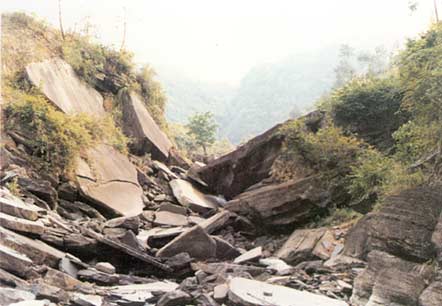
The Rock of Oenkmar still stuck within the old volcanic shaft, has become a location to explore. The temples and buildings from the Elves and the earlier older Azcan civilization harboured much knowledge and secrets, and the humanoids were willing to learn. It is in these years the magical powers of the humanoids rose to their current levels. Were they earlier only able to use a few primitive spells, now spells of true magic became available; Fireballs and similar...the humanoids became a power to take caution off. It is in this period several humanoid heroes became Immortal, they say themselves. Whatever, their influence upon the region became strong and permanent.
DM Info; Here a map of the region envisioning the size of The Oenkmar Empire 1000 BC
800 BC - 500 BC
This is the time in which there seems to be a continuous growth. Not only the humanoids, but most cultures and nations expand, in territory, number of inhabitants, and social structures like commerce, war, magic, architecture and agriculture. The wasting disease from the Blackmoor era slowly fades into a memory, leaving scars and marks behind. Whole nations have perished, moved or changed due this disease, and it greatly affected the life on Mystara.
Underground the magma further recedes, renoving the pressure on the Western half of the Broken Lands. The Eastern half however still continues to rise, due the increasing pressure of the lower Eastern Magma chamber. Especially the Gnollistan Plateaux seems to be affected by this. The Magma permeates through the solidifying rock of the upper chamber, but there seems still no connection....up to 500 BC.
The Plateaux is now populated by Humanoids and several "guest" races, amongst other Dwarves and Horon followers; refugees of a culture that came from the region South of Rockhome... Not much is left of this nation or culture, other than several large structures clearly build with dwarven technology, stonework and masonry. Whatever happened with this culture is completely unknown, no scriptures are found, and even the older living races have no knowledge of that culture. Even the refugees near Oenkmar seem to have dissapeared suddenly. It is as if the immortals want us to forget that culture for a reason, an obscure one, but still. What we do know is that the Empire of Oenkmar and the forgotten culture traded and made war upon eachother.
What remains of this culture are the Gnolls. Way to stupid and violent to being able to be that forgotten race, so they must have been tools of war or slavery. These wicked creatures rapidly affected the region, and settled on the Plateaux of Gnollistan. Many others of them spread over the Continent spreading war and havoc. They are known to have invaded Karameikos, the Shires, and are now even found in the Sind desert.
Other great changes to the region are the arrival of the Elves, the alteration of weather patterns and the creation of the Canolbarth Forest. This greatly affected the amounts of rain, and thus erosion by flooding water. One great example is the Black Hills, originally dry, and uninteresting, now many small creeks and brooks cobble down, feeding a new river; The Black Water River. The Twin Volcanoes deposits over the centuries and the pines that continuously expand upon the hills in this area produce chemicals that color the water dark. Hence the name.
One group of Elves disbanded, and settled north of the Broken Lands, and it is them that named Lake Erewan for the first time..the name of their clan. They merge with the Belcadiz elves who already live there, but are not really accepted in the Pre-glantrian culture, as they disdain themselves from human behavior. The Belcadiz Elves did adapt, much earlier and are more accepted. Forests are created/planted by these elves and they alter the course of the Red and Vesubian Rivers to their liking with the use of Dams. A technique, the humans on the Streel Plain used to protect them from the seasonal flooding of the Vesubian Riiver.
As the toxicity of Lake Grondheim slowly diminishes, the locals come in and start plundering the wood. Structures are built, fires are lit, and even tools and medicines are created. Some Glantrians in Bramyara use the remains to turn into compost, but must chip the wood down first.
Darokin starts its great rise of agricultural region. The sediments washed down the Broken Lands are rich in metals and minerals and in effect triple or even quadruple normal yields of harvest.
500 BC - 190 BC
Underground still a lot happens, the Western caves, give further room as more magma recedes, and water erosion from Trollhattan on the surface creeps in. The magma channels that go down, become slowly smaller in diameter, but the speed goes up.

This effect is caused by the enlarging of the eastern lower magma chamber, which slowly melts away the lower remains of the surface cells that once were here. In this large geological process, an enormous amount of pressure continues to grow.
The western magma chamber continued to go back down, creating a powerful flow down in the central magma chamber sections. The Eastern lower Magma chamber caused so much pressure, it literally pushed up the central magma chamber, which thus melted the plug underneath the old smaller magma chamber underneath the Plateaux of Gnollistan. As the magma went up, it melted the sand. As the current of the magma was going up AND down , the shaft of the old volcano melted and widened.

The last view of Sinking Oenkmar in the wide shaft of Lower Gnollistan. The smoke hides the size and details of the city.
And with the sinking of crystaline sand, the release of upward pressure on the Rock of Oenkmar, it followed down, but instead like before settling on the ground of the smaller upper magma chamber, it slid into the now widened shaft leading further down. The Rock of Oenkmar, impervious of heat, created in a volcano, floated on the Magma, trapping the humanoids on it. This was the end of the Humanoids golden era, the end of the age of Oenkmar.The upper smaller magma chamber slowly cooled down again, and the magma again hardened and crystalized into a fine sand. This sand can still be found in the Lower Gnollistancaves,...which actually are the smaller upper magma chamber, but now empty. Fresh air continues to come from above through the shaft of the old volcano. Only a few tunnels and housings in this upper sections of the shaft where Oenkmar was for so long remain its glory. As the number of survivors which were NOT on the Rock of Oenkmar were low, and humanoids have a short lifespan, and even shorter memory-span, Oenkmar was soon forgotten. The survivors on the Rock, however, did not forget. Entrapped upon a large floating rock on boiling magma they had from now on a very hard time to survive. The city proved to be selfreliant in the upcoming years, but sometimes at great costs. The sinking of the Oenkmar Rock, the dissapearance of the Lost Nation, and the arrival of the Alfheim Elves and creation of the Canolbarth Forest caused the Oenkmar empire to shrink and eventually dissapear (DM info; Oenkmar 500 BC).
The Red Orcland Lake is now almost fully washed down, or evaporated, leaving behind a vast desert of muck, that dries, hardens and breaks. It is now called by the few humans who ventured here; "The cracked earth"
The erosion of the rocky islands that existed in this former lake, leave behind small plateaus with a rocky top. These are up to this day used by the Red Orcs for various reasons.
One area doesn't dry up, a large pit of mud, replenished by the few small creeks that still exist in the region. There were valuable ores and metals in the mud. Natoka, a brave Orc warrior ventured here with a small army and battled the many mudmen (Note 2) that had staked out a mere existence here. He succeeded, and the mudmen were defeated, but the muddy pit became his grave. Up to this date the area is named after his demise by the Red Orcs.
Mudmen still exist in the region, but they are either enslaved or eradicated. A way of torturing death to these rare and strange earthlike creatures, is sending them into the dry and barren plain, viewing them to crackle, stiffen and breaking apart. Enslaved mudmen are threatened with death, and forced to do manual simple labor uner threat of fire. However as these creatures are neither strong or smart, they are mostly only used for covering areas with mud (for housing for example).
Then there is another great and important change. The Streel, Dol-Anur and Krandai Rivers empty themselves into Lake Grondheim together with a multitude of creeks, brooks and goblets. Yet from somewhere comes a river that suddenly appeared, and according to the few merchants with at least a spark of geological understanding able to return to the known world, and it flows UPHILL!!!.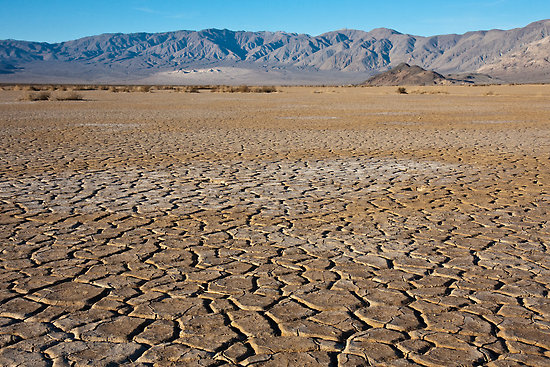
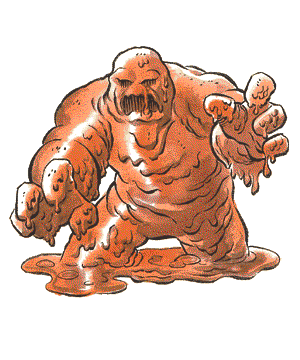
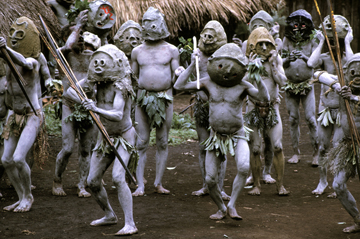
Like Stone Giants, Rockmen, Geonids, and Ghaleb-Duhr the Mudmen belong to the few creatures without a carbon-based but a silicon-based biological structure, as such they are also ovipareous.
Warning; Do not confuse Mudmen with Mudgolems, Mudmen are smaller, strange, but natural reproducing creatures, and seem to have some intelligence, while mudgolems are larger, and much, much more dangerous magical creations which follow preprogrammed commands in a limited frame of understanding (we can't call that intelligence).
As mudmen strike fear into most creatures not understanding their biological physique and behavior, Red Orcs sometimes emulate these creatures with clay-masks and a mud dirt covering upon their skins. These are often part of their rituals, or parties.
"This mystery will soon be solved, as I introduce to you Professor Gaston Vander Klil, who has been granted free research in Ethengar, and with lots of expertise in ventures into the Broken Lands themselves, will soon leave us and bring us back this secret".
Gaston Bowed. Salechaam, swallowed and almost choked upon his tongue..."The Broken Lands and Ethengar??? That is what he needs me for??...the Danger......Hey that must be a hefty pay..." were his soft-spoken words.
The crowd cheered, and several dwarves nearby congratulated Gaston and Salechaam, who they presumed was already hired...
"Back to the case of the region...", Mergrath continued loudly. Slowly the dwarves became silent again, many still viewed the couple, while Salechaam looked a bit downbeaten now he knew the possible adventure he would step in. A soft curse escaped his lips,...what did he gotten himself into.
The region was greatly affected by this strange effect. And as thus we are very interested in the cause..."looking back at Gaston. As this river had a flow rate as powerful as the three rivers and all the creeks combined or actually even somewhat stronger....Lake Grondheim slowly emptied. The waters going through the valley between the Gnollistan Plateaux and the Northern grassy plain, between the Twin Volcanoes, over the region Red-Orcland, splitting it up into an eastern and westen half. The eastern Half was abandoned, and rapidly taken over by the Kobolds.
The river gobbled down until it reached the Streel Plain where it connected the Vesubian River.
This river we now call the Streel River. The strongest current, is normally the name giver of a river and as thus the Lower Vesubian River became the Streel River, which instantly became the longest river of the Known World. The Dol-Anur being weaker and the Krandai river is actually flowing another direction, but that was not known consciously up to this date, as thus it was the Streel River that crossed the Broken Lands.
150 BC
As the lake slowly receded, the humans and humanoids followed and plundered the wet lands. the last dead trees fell, and finally even the last still standing pines died. The trunks of a bygone forest were slowly removed and used. The swamp engulfed the rest in a stench of the rotten muck...Bog logs. Where in 500 BC still was forest, now grass waved in the Ethengar wind.
And yet even the swamp slowly shrunk in size.
The magic Hakomon locations (as seen on above maps clockwise) of Hosjan (North of the Lake), Abukka-Lai (West of Streel River), Wourigusta (East of Streel River), Nin-Ji-Batu (North of Krandai River), Chimeibutu (south of Krandai), and Orkajinqertu (further South of Krandai River) slowly became stronger, purer, more defined, as if the volcanic and biological pollution of the lake affected the passing of magic.
The acid lake north of the Twin Volcanoes was emptied, but the Streel River flowing through it between the Twin Volcanoes Gvozdenžuba and Ježibaba. The naming of the volcanoes was done by the Goblins of Gobbleton, and was named by the same cause of the reason why the Streel River went UPstream. The acid water rushed through the broken lands and hills of Gobbleton, while Red Orcland was established more firmly. This combination of factors forced the Goblins to move into the mountains. It was not until this date they started to rebuild Akrass to their opinions. Unrtil now they only lived within the fortress of the Former Troll Queen. It was to become their sole achievement in architecture. Akrass is even up to this very day, one of the largest, so not THE largest fortress on Mystara.
0 AC (Crowning of Thyatis Emperor, begin calendar)
Back to the Acidic Streel River. The Grondheim Lake slowly reduced in volume, and much polluted water was drained uphill into the broken Lands. This caused the region the Humanoids now call Nankoweap, (the section between the Gnollistan Plateax and Hobgobland Plateaux) to become very infertile for a few centuries.
The area seemed calming down, but there was still enough activity.
The great geological effects may have reduced in intensity when compared with the earlier effects, but the still have great effects. Some cracks appear in the rocks between the Vesubian rivee and the Valley of Trollhattan. The water seeps in slowly, but becomes more powerful with each century. There is still some downward flow, as thus Trollhattan does not overflow...yet, but as soon as this is clogged (and eventually that will happen, but unknown is when, either by geological changes or debris clogging), the valley will become a vast lake. Probably with a pine forest growing a its sides.
The Plateaux of Zyrd is also an interesting feature. It has been proven that the whole plateau is a singlar slab of hard stone (maybe a solidified ancient wound crust or something similar). In its ancient times this area was the flat top of a mountain, of which sprang even a river flowing into lake Anur, this river’s origin was much lower and further away in 2300BC. But it can even be assumed that the area was originally even lower than that, as it encompasses the remains of a vast and ancient petrified forest. This forest is thus old that the trees have petrified by being submerged for aeons. Geology lifted the area up, erosion revealed the trees, and with the uplift through the ages, the forest reached a height it never attained.One thing is clear about this area; It is since 1700BC that the whole region is affected by an upward push in varying intensity and effect during the centuries. This push created the surrounding mountains, and pushed up the hilly area west thus high it became Mount Barbia at 15.355’ current height. This push does even continue today, especially since the Shadow Elves changed the lower areas thus that the Magma filled the magma chambers enabling Aengmor to be lifted back up. It can be certain that the Broken Lands region will continue to rise. More about this later.
The plateau "Akkila's Throne", which is actually NOT a plateau, but an area that seems elevated because the lower areas around it. To one side the remnants of a large lake which had depressed the underground for so long it clung together in a thick layer of clay. On to of this is the muck we know now, but is the remains of all the plant, and animal life of the area before the lake and of the lake itself. to the west the remnants of the mountain reveal it was higher here long ago. To the South we see the erosion caused by the earlier acid lake and effects of Grondheim Lake itself. Gnollistan, however, as being part of the central rocky section, continues to rise, and is a real Plateaux.
200 AC
The Acid Lake, did the same to the Southern Broken Lands, but its deadly effects went even further. As the water reached the Vesubian River, it killed or at least sickened all life living in or from this water. Crops died, cattle became weak, dead fish floating by was a normal sight in those days. This deprivation caused many farmers to become bandits and robbers. And it was this tension which finally led to the Elfwars in Darokin. Of course there were other additional factors, but the main reason was much, simpler, and slithery crawling into their life poisonous water. The acid water passed even by the south end of Gnollistan, affecting the Black Hills, and eventually changing the chemical base of this hills, in such a way, it darkened the water, making it less optimal for bacterial life, and thus also plants and fish. This continues up to today. Blackwaterlake, does harbor life, but much less than any normal lake would do.
It was only a few decades before the Crowning of Thyatian's Emperor that the Streel River finally became pure again. It was from this moment the growth of Darokin's farming produce began.
The last dead trees had fallen north of the still shrinking Grondheim Lake. The lake was now only about a quarter of its large size, but now had a vast swamp of tghat size around it. Within this swamp (north of Akkila's Throne) the Hobgoblin Wokany discovered a new Magic Location, which they called Garonn.
A multitude of minor eruptions of the Twin Volcanoes caused them to grow. They cut off any downpour from the former Acid Lake. The Streel had become the sole river through this side of the region.
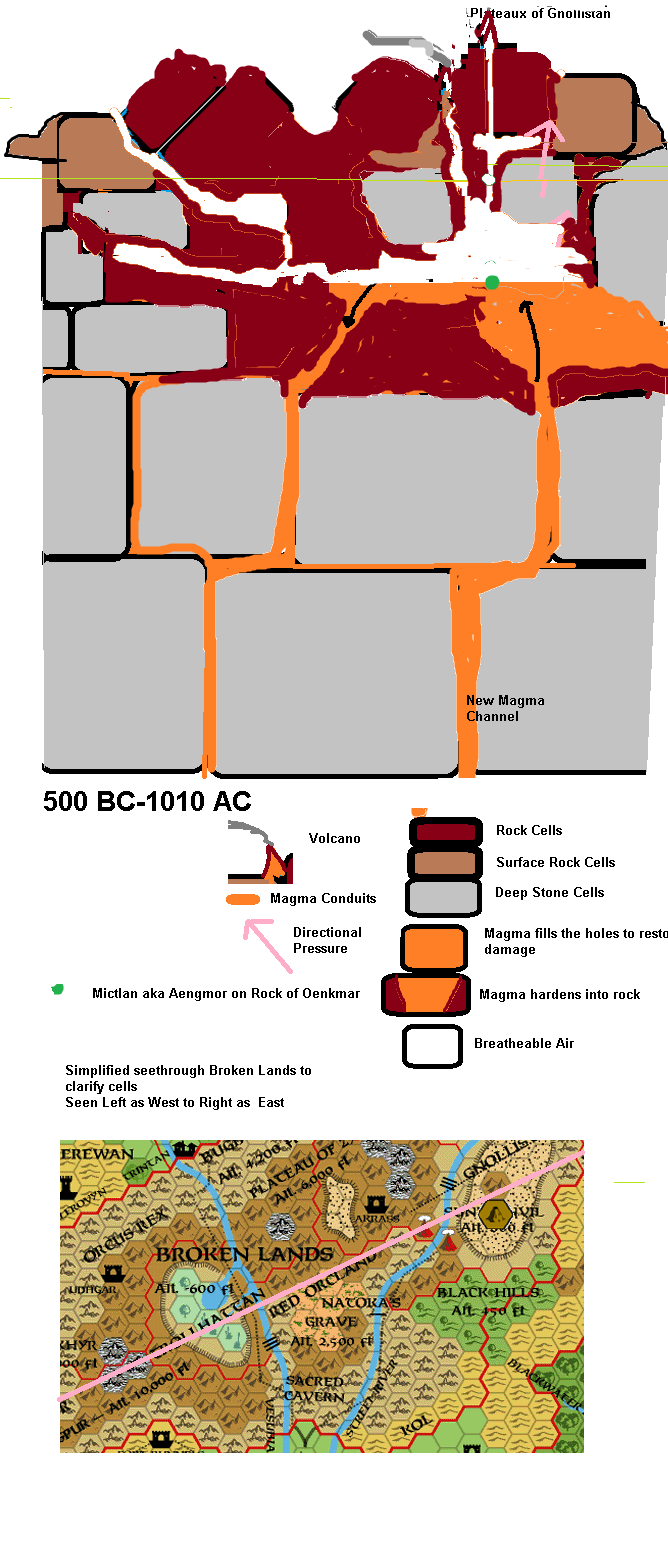
The upward force continues up to this date forcing the whole central area of the Broken Lands further up, as can be seen in the Geofase 7 map, the yellow Line depicts the affected areas. These include the Plateaux of Zyrd, - of Gnollistan, half the mountains of Goblinia, and all areas in between. The goblins even named a section merchants today use; "The Mountain that Died", which does reflect that southwest of the Twin Volcanoes a whole mountain collapsed. Although this area is indeed broken land, revealing great geological effects, earlier written history reveals that it was like this much earlier. As thus it can be assumed that "The Mountain that Died" has been a mountain pass or valley of some sort, which collapsed due to the Twin Volcano's activity, and thus remain in the Humanoid collective mind.
The Gnolls of Gnollistan take care of "their" land, the trunks of the former forest are being used for construction. Their Plateau is now thus high and hot, no trees can and will grow their anymore. A most unpleasant region, but preferred by the heat-loving Gnolls. Although not like Ylaruam, the gnolls do their bests to make it look that way.
The Grondheim Lake has been emptied thus far, that even the swamps surounding it start to dry out, and become Ethengar grasslands.
One large section of the Former Lake, between to spurs of Dwarfgate mountains falls completely dry. This is discovered by several proud and brave Dwarven explorers, who discover an ancient Obelisk and the ruins of an ancient Blackmoor city. They succeed in bringing the material of their discovery home to Dengar, but upon their second voyage they fell victim to some unknown danger, and never returned.
Around 500 AC;
Beware, not only Humanoids live in the region, several monsters also, and undead are assumed too.
Explorers from both Glantri and Darokin discover a path along the Vesubian River. Soon dwarves are hired to widen the path were possible. Many guards, dwarves and other explorers perished, and this was only the beginning. The humans, however, continued in creating the Trintan-Corunglain Trail. The first merchant trail between Glantri and Darokin, that did not need to go far west or east (Rockhome) circling around the Broken Lands.
The Grondheim Lake now holds a small lake of 30-40 miles and a double area of swamp. The remaining sections of the former lake have slowly been taken over by the grasslands of Ethengar. And within this grassy encroachment, the Ethengar warriors followed. They went towards the Magic Location owned by the Hobgoblins; Garonn. The force had several Hakomon magicusers with them, which soon discovered the power of this location. The humanoids were forcefully driven away, up to "their" plateau. The nimble horses of the Ethengar were unable to traverse in the rim of Broken Lands, and their attack was halted. Up to this day the Ethengar tribe of Taijits regularly patrol this region in a (feeble) attempt to keep the Humanoids out. Both Hakomon and Hobgoblin Wokani keep using Garonn, but within the area itself any combat is refrained from. It may be weird and even strange, but here the Hakomon and Hobgoblin Wokani may even work together, while battling each-other elsewhere.
800 AC
Around 625 AC, the same happened along the Streel River. A much longer route, but in a geological aspect much easier and diverse.
These passes opened the Northern Realms to the Darokin Trade.
The southern part of the Lakebed rapidly dries out. Strange finds from bygone eras become visible; metal vessels, rusted and seemingly haunted. Whatever is there, only the Yellow Orcs dared to settle in the area, while to their south Stone creatures like Stone giants and Rockmen are discovered.
The Yellow Orcs could however, not endure the bounties of this land for long. Salty deposits on this former lakebed, rapidly deprived the area of more and more vegetation with each year. There is no more lake (other than a small 2 mile "puddle") where the Dol-Anur and Streel intersect. The whole northern area is now either grassland or swamps.
1000AC+
No, it does not.
In 1006 AC a huge meteor impacted near the west of the Broken Lands. It fell in an angle, severely slowed down by the Worldshield, but the damage was tremendous.
As the Dwarves discovered an ancient Humanoid City with the name Oenkmar in 1012 AC. They proudly started a war with the Humanoids for all the treasures buried within this lava-floating island city. However, halfway the battle the Shadowelves learned of their exploits, and decided that Oenkmar, must be Aengmor, their ancient city lost sooo long ago by them. Already battle-beaten, the Dwarves could not resist another army attacking from behind and had to retreat....
The region of Red Orcland, also a former lake, suffers from the same heat as Yellow Orkia and Gnollistan. It is therefor assumed that the heat of the lower magma chambers somehow penetrate the ground, vibrating up in the air and thus affecting the local weather from the Red Orcland's edge against the Vesubian, along the Streel, the Twin Volcanoes, Gnollistan and Yellow Orkia in a path of 25 to 40 miles wide.
From Dwarven underground explorers we have discovered that there is indeed a huge magma chamber below, following the same general area on the surface. This heat is the main reason for the biological and ecological changes found within this area.
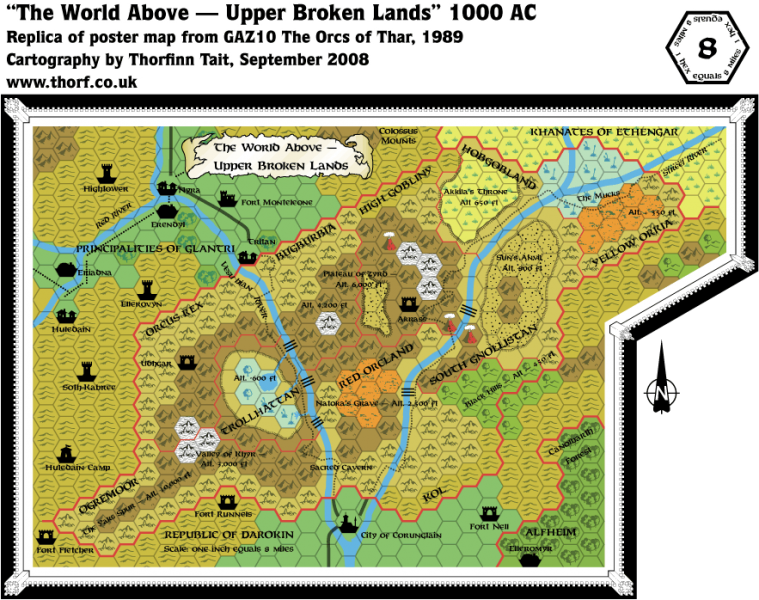
The area is now already about one century almost equal to the maps we all know. Even though these various maps hold several flaws, this one has the least.
When the area cooled down, a huge crater was where first the Silver Sierra Mountains were, where provinces of Glantri did exist. The impact was so severe that almost none on the Known World would NOT have noticed or harmed by it.
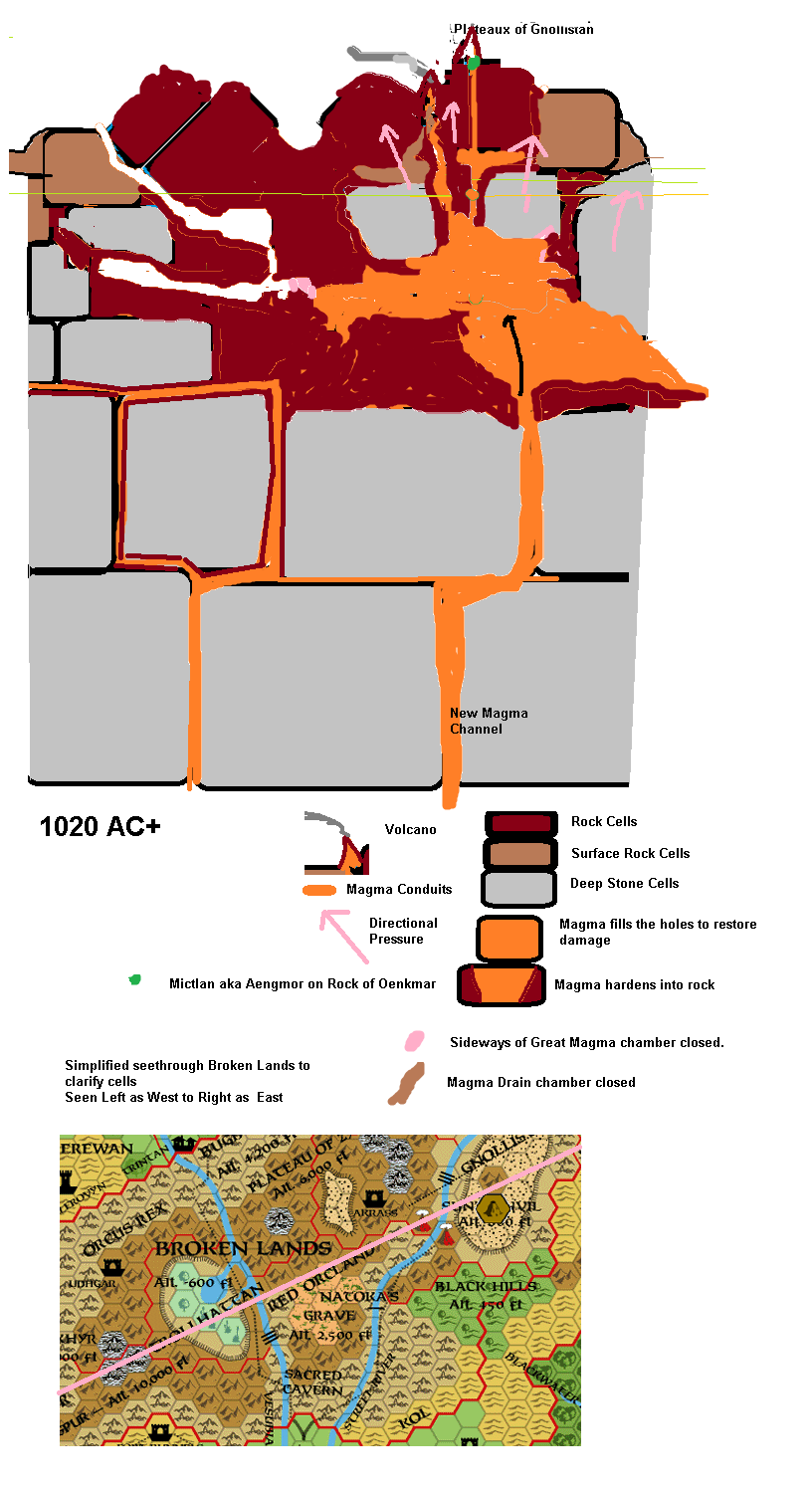
The crowd jeered and shouted. Many curses and profanities were spread. The pain of the defeat was still alive in many of these Dwarves.
1014 AC
King Everast send spies..."Mergrath continued"....even the Shadowelven were unaware of, and they learned the following. With their ground altering magic the Shadowelves closed of several sidepassages of the great Magma chamvber below, but also a major downflow channel. As thus the great chamber slowly filled, carefully they guided Aengmor to beneath its original location, while it was pushed upwards with the rising Magma.
While doing so, the Shadow Elves of Aengmor religiously diverted to the Immortal Atzanteotl, an evil entity. At first the shadowelves evicted all humanoids from the city, then from the lower caves, and then even from the surface.
The fleeing Humanoids entered the Great Crater, finding many fissures and large caves below. Adaptive critters as they are, the settled, and even managed to be acceped by the Glantrian mages as Magic using Princes...the ludicruosity...
As the cultural split of the Shadowelves continued, the Humanoids slowly retook their surface of the Broken Lands.
1020 AC
And now...? The Shadowelves have turned into "Drow" or Dark Elves, and now follow even another vile immortal. They have learned that they will never be able to adapt to the surface world like their normal elven cousins, and are even further angered by their Shadowelven relatives, who still try to do so. The Humanoids are accepted back in their caves, which have radically changed with all the closed conduits, and now they have to accept Dark Elves as Rulers.
Thus far the Geomorphological history of the Broken Lands"...Mergrath looked over the crowd...he had not noticed that while his speech his audence quadrupled. Where-ever you looked, you saw Dwarves, and no single spot was free. Some even hung on trapezes from the ceiling...."I hope you all learned something from this story...namely, that even the ground you walk upon, will change, slowly, but inevitably. or sometimes rapidly with devastating effects. This is what the broken Lands are. Until a next time, with another story or another lesson, I bid all of you goodby and a fine day. May gold be found under your footsteps."
With these final words Mergrath slowly transformed or was taken into a Huge Earth elemental and faded through the ground away. While this happened the crowd applauded. and then slowly dispersed.
"We have to talk Salechaam" Gaston spoke loudly to overcome the mumbling noise. "I have a great adventure ready for you...with great rewards."
The Dwarf looked up; "It better be..." he mumbled in his fletched beard.
.
For any interested in what precisly happened after 1010 AC read Theshold Magazine 10
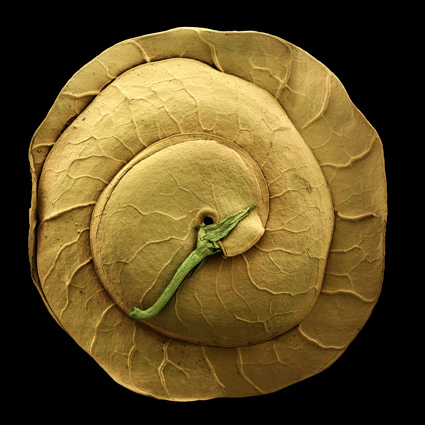
Note 1
Airspores
Mystara Information; Air spores are found in most deserts and come from the "Medicago orbicularis" plant (which is a Herb, for game statistics see my monster manual compilation chapter Lowlife, page 844), or “Airbloom”. It forms a symbiotic relationship with bacterium Sinorhizobium medicae, which is capable of Nitrogen fixation and large amounts of O2 and CO2 production. Growing in desert gardens and oasis, these 3 to 5 foot high thin bushes give blooms which can be found year round, and produce the Airspore seedpods. Every week 1d4 2 inch diameter round-disc-shaped Airspores can be found for every 10 plants. These bushes live no more than 2 years give blooms after 6 months, when having enough water only.
These spores when ingested whole provide the user with 4+1d4 hours of breathable air (in the perfect mixture for normal demi-human-(oid)-s). As thus the imbiber becomes invulnerable to poisonous air, noxious gasses and even lack of air..
The spores however do not affect how acidic gasses might affect the body exterior, and items, but instead only gives air to breathe. Thus acidic, hot, or freezing gasses still give damage (-25% as this is the damage normally caused internally). It is up to the user to get away as fast as possible when gasses cause other damage, or use other means to resist that.
These spores are collected in small pouches of 10 (11cn) or 20 (23cn) and sold for respectively 50 and 100 gold on Ylari and Rockhome markets.
Dried Airspores are good 6 month and then start losing efficiency (-1 hour/month of age over 6). Fresh spores, are green and not usable, but need minimum of 4 hours in hot sunlight to dry (or 4 days in warm sunlight).
The plants spread themselves with the tiny seeds in the spores, which come free after about an additional 6 to 8 hours after ingestion, by passing through the body of the host, and only then are able to grow on the manure in the right circumstances.
The spores can also be used in Herbalogy/Apothecary to help curing long diseases. (+3 to save to cure).
From the Game AD&D2 Ravenloft, Stone Prophet, with help of Wikipedia.
This plant does NOT do the same in the Real World. Do not eat plants you do not know!!. I am NOT responsible for any mishaps if you do!!
Note 2
Mudmen Caeno homininoides
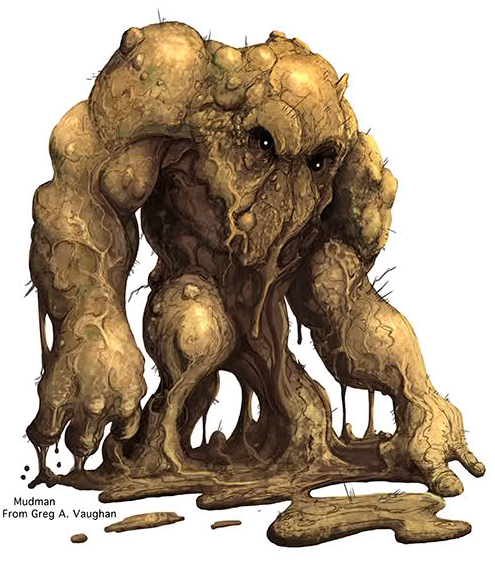
Climate/Terrain; Any pool or large muddy area
Frequency; Very rare
Organization; Pack or solitary
Activity Cycle: Any, but Night preferred, as they dislike the heat of the sun.
Diet; Algea, spores, mosses, plants in ground or magical Dweomer
Abilities; ST 6+2d4, IN2+1d4, WI 2d6, CO 2d8, DX 4+1d4, CH 1d4
Treasure; Nil
ALignment; Neutral
NA; 2d6
AC; 9
MV; 30'-10'
HD; 2*
THAC0: 19
Att; 1 fist slam
Dm; Special
Special Attacks; Mud-throwing, suffocation
Special defences;See below
MR; Nil
Size; Small (4' high)
Morale; Special
XP Value; 25
Mudmen are formed in pools of mudmagic locations in a former wet area exists (like Red Orc Land in the Broken Lands), and where enchanted rivers (even mildly enchanted ones, such as a stream eroding a magical structure) collect and evaporate and concentrate the dweomer. Because they are essentially creatures of magic, mudmen are sometimes called dweomerlings. A protection from Magic will hold these creatures at bay. Mudmen are almost intelligent life forces with but one goal; to protect their pools against intruders.
When aroused into a physical form, mudmen take on the appearance of animated mud in a stocky humanoid shape, about 4 feet tall. Their coloration varies between a dirty brown and tar black. They have four thick fingers on each hand. Their legs stay submerged within the pool, and are not usually visible. Their eyes are pools of jet black shadow and enables them to see with a infravion-normal vision mixture 45' in day light to 180' in night. They are blinded with magic light, or intense sunlight(which they dispise).
Mudmen speak no languages and are incapable of communicating with any living creature.
Combat: In their dormant state, mudmen wait beneath the surface of the pool, spread on the bottom, feeding on the dweomer. In this state they are immune to all weapons, even magical ones. Spells that normally harm a mudmen will still affect it, although damage is divided evenly among all the mudmen in the pool (the entire group counts as one creature for these effects, and fractions are rounded down).
When a creature enters the pool the mudmen immediately sense its presence or when it is seen by non dormant mudmen, they take but a single round to draw their substance together and rise to the surface, ready to attack on the following round. Once fully formed and standing, a mudmen can be harmed by magical weapons. Mudmen attack by hurling mud at their opponents, who are considered AC 9 (modified by target's Dexterity only) for the purpose of determining hits. Mud hardens instantly on impact and slows the creature's movement rate and initiative by 10% if it hits. While hurling mud, a mudman will also advance on its victim at its full movement rate. Once within 10 feet, it will hurl itself (literally) at the victim in an attempt to suffocate its target. A sucessful hit means the victim's movement and initiative is reduced by 40%. A victim must holds its breath for 1/3 his constitution in rounds or die by suffocation. A victim can only escape when the Mudmen is dead. Any damage suffered to the Mudmen will also be given to its victim(unless immunities apply). A miss means the mudman must spend the next round re-forming in order to attack again.
Once a victim's movement or initiative is brought to 0, he becomes immobilized and suffocates, suffering 1-8 points of damage per round until the mouth or nose is clear. The victim will die of suffocation in 5 consecutive rounds unless rescued. Hardened mud can be cleared from a character's nose and mouth in one round. Movement can be restored at a rate of 10% per five rounds. If the creature flees the pool, the mudmen will normally not pursue. Their main interest is the Pool. Instead, they sink into the depths, return to their dormant state, and wait until the next time someone enters the pool.
Mudmen may wander about like normal creatures in search of food and nutrients, but take care. It is vulnerable to many things; rapid flowing water, drought, heat, bushes. Each of these will cause it 1d4 damage for each round in contact or affected by it.
Mudmen are affected by all spells that cause damage to living creatures (e.g., cause light wounds, magic missile, fireball, flame strike). Dispel magic and dig act as fireballs cast at the same level as the mage. Transmute mud to rock, petrification of any form including freezing and fire or heat kills all mudmen within its area of effect, with no saving throw allowed.
Mudmen are immune to all poisons, natural and magical, and are unaffected by spells that affect the mind (e.g., hold, charm, and sleep).
Habitat/Society: Mudmen have two states: rest and activity, the latter of which solely involves killing intruders. A mudman's pool varies in size between 20 and 200 feet in diameter. Such pools are often found near waterfalls, or in almost dried up lakes.
Ecology: Mudmen are silicon based creatures and at the bottom of the ecosystem. They try to kill all natural creatures that encounter them and have no natural enemies other than the environment. Over a long period of time they absorb flesh, wood, and bone, extracting whatever they can get from it, so they rarely possess any treasure, only if they were attacked within the last month by someone who was bearing treasure. Though no uses have been recorded for a mudman's mud, it is logical that mages would not ignore its magical properties. Magic items within a pool lose 10% of its dweomer per day, excluding artifacts and within natural locations (they prefer to feed from the source instead an item). Mudmen arise spontaneously within magic mud, but normally reproduce by Asexual reproduction called Fragmentation. Fragmentation is a form of asexual reproduction where a new organism grows from a fragment of the parent (as long as it is within dweomer rich mud). Why and how the creature does so is not fully understood, but they do so only once in their maximum 10 year long life.These 1 foot large fragments are called eggs, and are harder, more solid than the mud around it. When a pool dries up these eggs harden like hardened mud, but do not die. When water is brought to it, it will again grow. Each fragment develops into a mature, fully grown individual in 2 days. Eggs are much better resistant to heat and drought than living individuals and suffer only 1% of damage from these effects, but the do not heal, unless in mud or water.
They have no males or females. As individuals they may wonder around in search of food. They know themselves individuality, even recognize species, but do not name themselves or others, or recognize other indentities. In Red Orcland Broken Lands they all hate Orcs.
Mudmen heal all damage sustained at a rate of 1 hp per day, if they are in dormant state.
Although somehow sentient, these silicon based life forms are not listed with Humanoids but with Monsters instead. The also do exist in the Plane of Matter.
